 19/11/2009 02:39 19/11/2009 02:39 |
|
| | | OFFLINE | | Post: 18.900
Post: 1.548 | Registrato il: 28/08/2005
Registrato il: 20/01/2009 | Administratore | Utente Veteran | |
|

 See preceding page for all other 11/19/09 stories, including the full text of the Holy Father's catechesis
See preceding page for all other 11/19/09 stories, including the full text of the Holy Father's catechesis
on the medieval cathedrals of Europe.
 The way of beauty
The way of beauty
Editorial
by Giovanni Maria Vian
Translated from
the 11/19/09 issue of


Benedict XVI shows with exemplary clarity what Christian tradition means to him in his catechesis on cathedrals, one of Europe's most splendid legacies from the Middle Ages.
It is an era that is often and wrongly seen even today as a succession of dark centuries, but which the Pope has exalted and described as Christian. Above all from the historical point of view, but not limited to that.
The "white garments of new churches" described by Rodolfo il Glabro was woven, in fact, with the economic support of "the entire Christian and civilian community". An epic achievement renewed today with Antonio Gaudi's masterpiece in Barcelona, the Sagrada Familia cathedral that is proceeding to completion.
Christian tradition is not alive only in the desire for God and the love for letters that characterized monastic theology as studied by the Benedictine historian Jean Leclercq, so dear to Benedict XVI who has cited him often.
This tradition shines, in fact, brlliant as medieval stained glass, even in the arts. Art has distinguished Europe continuously, with fruits and symbols that are repeated even today. Like the Cross represented during the mid-19th century in one of the largest halls of the Senate of the French Republic, almost like a seal, even if secular, of the country's history.
For many years, European art has used the multicolored alphabet of the Bible - the Pope said, citing Marc Chagall - and is therefore incomprehensible without keeping in mind its religious inspiration. Which is born, as St. Augustine said, from the intuition that one of the ways to reach God is precisely the way of beauty.
And if you have not yet read the Pope's catechesis on the cathedrals, read it in the preceding page.
Benedict XVI not only teaches the essentials of the faith - he also opens the eyes of faith, and does what sublime Christian art does, which is 'to make the Invisible visible'.
Here's Avvvenire's editorial on the same subject:
Pope Benedict: Spiritual appreciation
of the beauty of God preserves the world
Editorial
by PIERANGELO SEQUERI
Translated from

Nov. 19, 2009
Now, even the stones speak to us.
In aging Europe, almost nothing flies 'high' anymore, not even rags. We are sinners, we human beings, that is true. And yet, we are people capable of supporting a lot, for some beautiful sign of the spirit that stirs us within and makes us want to explain to our children what it means that "man does not live by bread alone".
Bread is necessary, and to earn one's daily bread is a sacrosanct duty. With bread, we can get by. But we need something else to live by.
And that something is not only for clerics and intellectuals - do not under-estimate us, you chattering crickets of the media. It has to do with a more 'beautiful' life for everyone.
How insupportable now is the great spiritual apostasy that the powers-that-be would 'civilize' us with at all costs! Which would be followed in the coming generations - already, we see the symptoms - by the anesthetization of all human senses.
Yes, of the senses, because we have our eyes so full of images that we have become myopic; we are completely surrounded by sounds that we can no longer hear anything. The smell of things is a vague memory, as we take in substances that take away our sense of smell. We touch everything, while nothing is able to touch us any more: not the intimacy of joy or pain, whether it's ours or that of others - we only know them as fillers in advertising spots aiming to sell us something.
We no longer know secrets, emotions, those impulses of truth that strike the heart, nor arching memories that endure. When the senses are obscured, we lose our soul.
The reason is simple. Our senses are made for the qualities of the spirit: if you empty the senses systematically of this vitality, you will find yourself blunted beyond repair in that which we call our sensibility - the highest and most precious quality of a human being, which has nothi9ng to do with sensory excitation.
Human sensibility is under fire. Forced to take cover and scorned, it is somthing that cannot be surgically transplanted. The signs of the weather we can read in meteorology; the signs of life, under the microscope; and the signs of current history, in the stock markets.
But the strongest and most beautiful signs are those of human sensibility, and many of them are intertwined with religion. This is not surprising: religion is the womb that holds the most ancient wisdom about the signs of the soul, its most profound enigmas, its most painful contradictions, its most exalted visions.
Nor is it strange that the spiritual wisdom of the senses - or rather, of human sensibility - has inscribed itself in our known history, right here in Europe. Where art has, for centuries, dipped its paintbrush and its quill "into that multicolored alphabet that is the Bible", as Marc Chagall said.
The latest catechesis of Benedict XVI, on the era of cathedrals, which closed with that citation from Chagall, opened with one from a famous chronicler of the year 1000, Rodolfo il Glabro (Rudolph the Bald, a Cluniac monk), who recounted the extraordinary fervor with which, in times that were particularly discouraging and difficult, the peoples of Europe competed with each other to invest their finest sensibilities and their best art in "shrugging off the old rags from their backs", puring out the passions of their soul to create the most beautiful forms in sacred places.
Like fresh 'white robes' for themselves: to look at, to touch, to smell, to make them feel alive, to fill them with hope.
Sacrosanct and well-earned, in the midst of a thousand efforts to keep alive body and soul - which mostly did not count with the powers of an age that was, by definition, 'medieval'.
But a fantastic spiritual investment that warded off the end of a world. And left us with some things that still soar high, even for us.
May the chronicler of the third millennium be able to give an unprejudiced account of man's surviving passion for the beauty of God, which saves not only our souls, but preserves the world for us.
 Left photos, Cathedral of Chartres and one of its stained-glass windows; right photos, interior of abbey church and exterior view of Mont St. Michel.
Left photos, Cathedral of Chartres and one of its stained-glass windows; right photos, interior of abbey church and exterior view of Mont St. Michel.
With eternal thanks to Henry Adams whose classic Mont St. Michel and Chartres first awakened my soul to the glories of the Gothic.
[Modificato da TERESA BENEDETTA 20/11/2009 01:48] |
| |
|
| |
 19/11/2009 04:17 19/11/2009 04:17 |
|
| | | OFFLINE | | Post: 18.901
Post: 1.549 | Registrato il: 28/08/2005
Registrato il: 20/01/2009 | Administratore | Utente Veteran | |
|
 The root of the crisis:
The root of the crisis:
When the State comes before the person
by Ettore Gotti Tedeschi
Translated from
the 11/19/09 issue of

On November 12, in Montecitorio [seat of the Italian Senate], Cardinal Tarcisio Bertone, speaking on tHE anniversary of the visit there of John Paul II, called on institutions to work in order that "the laws of the State do not harm in any way the right to life, but rather, promote the defense of the fundamental rights of the human being, particularly the weaker ones".
Thus, the Secretary of state took up the appeal voiced in Caritas in veritate, in continunity with Paul VI's encyclicals Humanae vitae and Populorum progressio.
One can never insist enough on the fact that States should be subsidiaries to the citizens and not vice-versa. That is why the lessons one can draw from the present economic crisis are important.
The crisis shows that the hopes expressed in Benedict XVI's encyclicals have not been taken into account. One would say instead that the person has been considered a means, an instrument, rather than the end, for the demands of States, becoming subsidiary to the will for even more power.
This is shown by the origin of the crisis, which arose, above all, by the decline of the birth rate. This has been allowed and even encouraged, and now, there is an attempt to make up for it by tricked-up economic growth, based on the unsustainable indebtedness of families, and consequently, on their vulnerability and weakness.
As a concrete example, consider the indebtedness of American families in the last ten years. The percentage of their debt with respect to the gross domestic product has gone up from 68% to 96% to sustain a fictitious economic growth that was consumer-driven and on credit. In ten years, the GDP grew by 28 percent due to credit.
It was a trumped-up growth which was badly managed which then provoked collateral damages, destroying wealth and generating unemployment even in Europe.
This phenomenon of a forced excess in indebtedness requires today a corrective maneuver of reduction (de-leveraging is the technical term), amounting to almost 25 trillion euros [???], a figure that is almost twice the U.S. GDP and one-fourth of global financial activity - with an inevitable negative impact on growth.
The new perception of risk by the banks, their consequent refusal to finance businesses (almost 40% less financing available) and the collapse of international commercial exchanges (down 15% in the past 12 months) are harsh and clear proof of the phenomenon just described.
The United Nations World Population report for 2009 says that in 2010, the working population in Italy, now at 39.3 million, will start to be less valuable in absolute values, producing more problems.
To compensate for the impact of such a demographic change - which will mean a 0.4% reduction in the GDP - and to maintain a projected 1.5% growth in 2011, it will be necessary to increase productivity by at least 1.9%. But to do this, one must dispose of a technological capacity which, unfortunately, is one of the weaknesses from which Italy suffers.
Evidently, GDP growth is shifting towards the east, or better, that it is now being managed in the east, and that Italy is reducing its contribution to development. In fact, more than 70% of Italian exports are directed to Europe which, according to forecasts, will have half the growth rate in thw next five years compared to the previous five. With the imaginable consquences on the employment and wellbeing of weaker citizens.
Probably it was because of this that Cardinal Bertone conclused his address in Montecitorio with the hope that Italy may affirm "its capacity to generate culture drawing from an intimate union between the vertical dimension towards God and the impulse of service towards one's neighbor".
The State should be subsidiary to the person, and not the person to the State. Even in this way, one defends "the fundamental rights of the human being, especially those who are weaker". Including his economic rights.
[Modificato da TERESA BENEDETTA 20/11/2010 00:06] |
| |
 19/11/2009 13:48 19/11/2009 13:48 |
|
| | | OFFLINE | | Post: 18.902
Post: 1.550 | Registrato il: 28/08/2005
Registrato il: 20/01/2009 | Administratore | Utente Veteran | |
|
 Thursday, Nov, 19
Thursday, Nov, 19
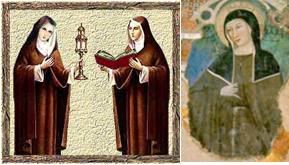 ST. AGNES OF ASSISI (1193-1253)
ST. AGNES OF ASSISI (1193-1253)
Poor Clare Nun and Abbess
A younger sister of St. Clare, she followed her sister to St. Francis's second order.
It is said that various miraculous interventions prevented her family's efforts to get
her back. Eventually, her sister sent her to set up a convent in Tuscany, the first of
many that she established. She died three months after Clare, and is buried with her.
She was canonized in 1753.
OR today.
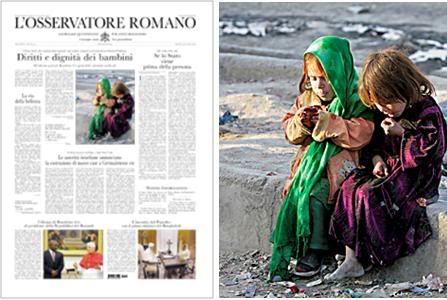
The Pope calls on the international community for an adequate response
to the tragic problems of childhood, and respect for
The rights and dignity of children
At the General Audience, the Pope's catechesis is on the medieval cathedrals of Europe.
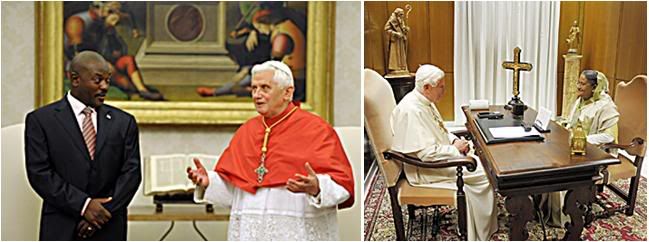 Other papal stories on Page 1: The papal audiences with the President of Burundi and the Prime Minister of Bangladesh;
Other papal stories on Page 1: The papal audiences with the President of Burundi and the Prime Minister of Bangladesh;
and an editorial on his catechesis about the 'way of beauty' as an approach to God. Also, an editorial commentary that
the principles of Caritas in veritate will never be put into practice as long as the interests of the State are placed ahead
of the individual; and Israelis announce new construction in East Jerusalem. Inside, there is an essay on the Abbey of St. Denis
in Paris, considered to be the first Gothic church; and a commentary on the implications of the presence of water on the moon.
THE POPE'S DAY
The Holy Father met today with
- Bishops of Brazil (South Sector-I, Group 5) on ad limina visit.
This group consists of Cardinal Odilo Scherer, Archbishop of Sao Paolo, and his auxiliaries.
- Professors and students of the Pontifical Universities in Rome and participants
in the current General Assembly of the International Federation of Catholic Universities.
Address in Italian.
Papal appointments announced today:
- Mons. Manuel Monteiro de Castro, secretary of the Congregation for Bishops, and
- Mons. Jean-Louis Brugues,
secretary of the Congregation for Catholic Education,
as consultors to the Congregation for the Doctrine of the Faith.
- John Cavadini, professor of theology at the University of Notre Dame, as a member of
the International Theological Commission.
'MONTHLY ANNIVERSARY'


FOUR YEARS, SEVEN MONTHS, AND COUNTING....
AD MULTOS ANNOS, SANCTO PATER!
THANK YOU FOR ALL YOU ARE
TO THE CHURCH, TO THE WORLD, TO ALL OF US.

[Modificato da TERESA BENEDETTA 25/11/2009 19:40] |
| |
 19/11/2009 18:39 19/11/2009 18:39 |
|
| | | OFFLINE | | Post: 18.904
Post: 1.552 | Registrato il: 28/08/2005
Registrato il: 20/01/2009 | Administratore | Utente Veteran | |
|
 PROMOTING KNOWLEDGE
PROMOTING KNOWLEDGE
ILLUMINATED BY FAITH

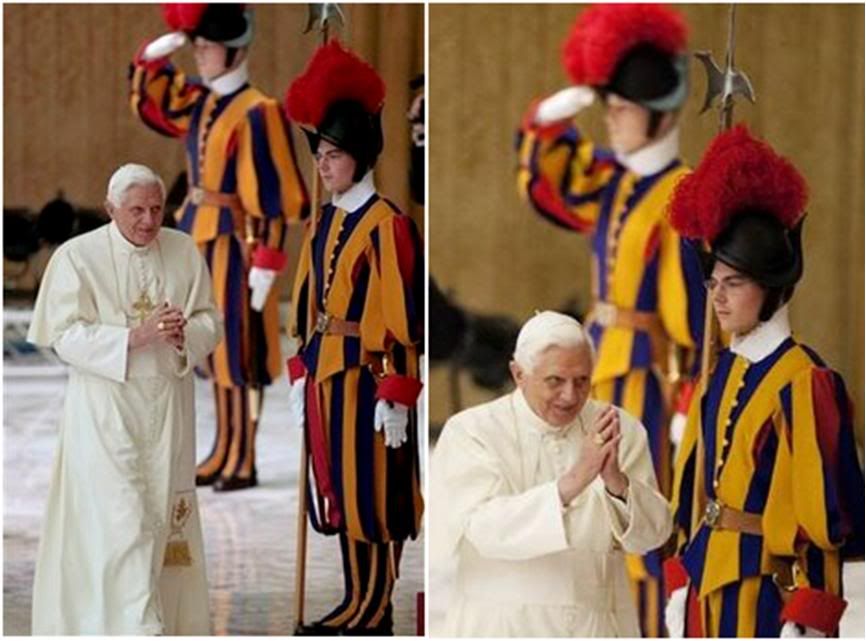
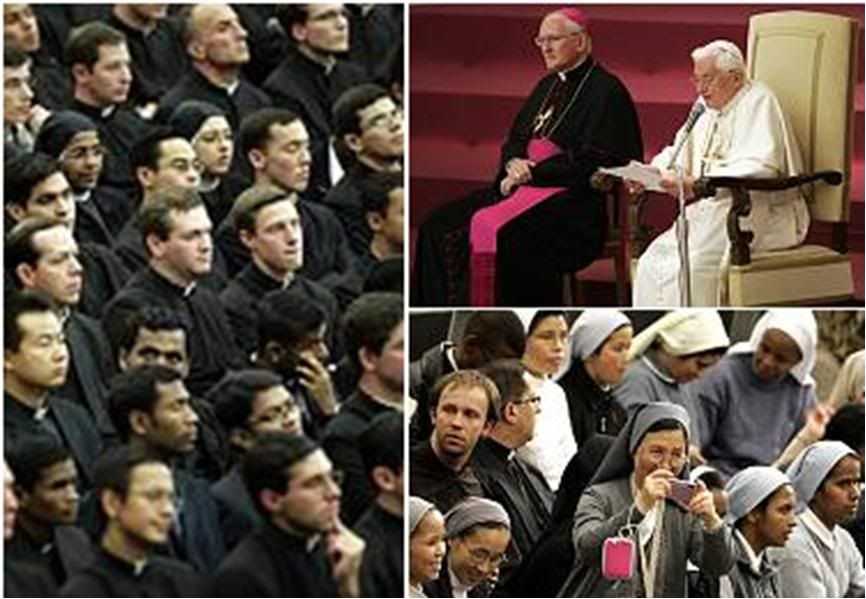
VATICAN CITY, 19 NOV 2009 (VIS) - At midday today in the Vatican's Paul VI Hall, the Pope received professors and students of Roman pontifical universities, and participants in the general assembly of the International Federation of Catholic Universities (FIUC).
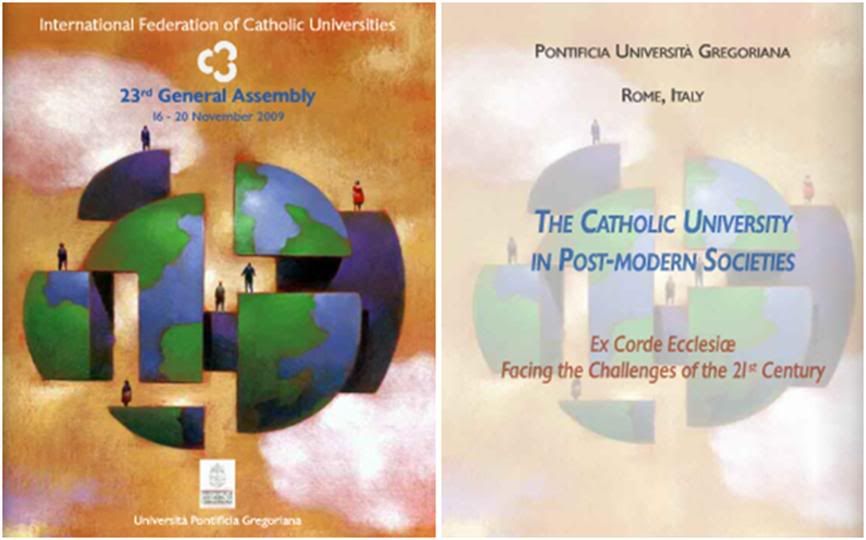
At the beginning of his address the Holy Father recalled how John Paul II's Apostolic Constitution Sapientia christiana, the thirtieth anniversary of which falls this year, "underlines the urgent need, which still persists today, to overcome the separation between faith and culture, calling for a greater commitment to evangelization in the firm conviction that Christian Revelation is a transforming power destined to permeate patterns of thought, standards of judgment and norms of behaviour."
"It is capable of illuminating, purifying and renewing man's conduct and his cultures, and must remain the focal point for teaching and research, as well as the horizon illuminating the nature and goals of all ecclesiastical faculties".
The underlying ideas of Sapientia christiana, Benedict XVI went on, "still retain all their validity. Indeed, in modern society where knowledge is becoming ever more specialised and sectorial but is profoundly marked by relativism, it is even more necessary to open oneself to the wisdom which comes from the Gospel. Man, in fact, is incapable of gaining a full understanding of himself and the world without Jesus Christ; He alone illuminates man's true dignity, his vocation and ultimate destiny, and opens his heart to a firm and lasting hope".
Professors and students "must never lose sight of the goal to be pursued, that of becoming instruments for the announcement of the Gospel. ... At the same time, it is important to remember that the study of the sacred sciences must never be separated from prayer, from union with God, from contemplation, ... otherwise reflection on the divine Mysteries risks becoming an empty intellectual exercise".
Turning then to address participants in the general assembly of the FIUC, which this year celebrates the sixtieth anniversary of its canonical recognition, the Holy Father encouraged them to make "further efforts to renew your will to serve the Church. In this context, your motto also represents a programme for the future of the federation: 'Sciat ut serviat', to know in order to serve.
"In a culture which reveals a 'lack of wisdom and reflection, a lack of thinking capable of formulating a guiding synthesis'", he added in conclusion, "Catholic universities, faithful to an identity which makes a specific point of Christian inspiration, are called to promote a 'new humanistic synthesis', knowledge that is 'wisdom capable of directing man in the light of his first beginnings and his final ends', knowledge illuminated by faith".
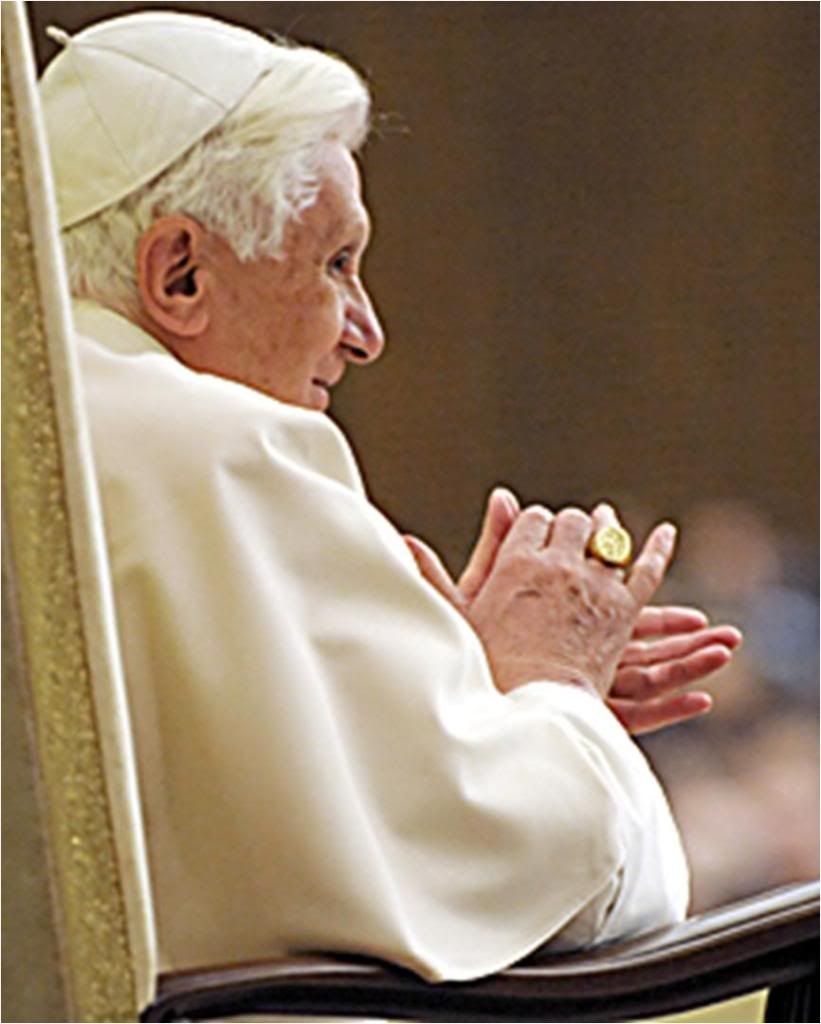 Here is a full translation of the Pope's address:
Here is a full translation of the Pope's address:
Eminent Cardinals,
Venerated brothers in the Episcopate and Priesthood,
distinguished Rectors, Academic Officers and Professors,
Dear students, brothers and sisters!
It is with joy that I welcome you and thank you for having convened ad Petri sedem to be confirmed in your important and demanding task of teaching, study and research in the service of the Church and of the entire society.
I warmly thank Cardinal Zenon Grocholewski for the words which he addressed to me in introducing this encounter, during which we mark two occasions: the 30th anniversary of the Apostolic Constitution Sapientia christiana (Christian wisdom), promulgated on April 15, 1979, by the Servant of God John Paul II, and the 60th anniversary of the recognition by the Holy See of the Statutes of the Fédération Internationale des Universités Catholiques (FIUC).
I am happy to recall these significant events with you, which gives me the occasion to highlight once more the irreplaceable role of ecclesiastical faculties and Catholic universities in the Church and in society.
The Second Vatican Council underscored this in the Declaration Gravissimum educationis, when it called on ecclesiastical faculties to undertake a more profound study in the various sacred sciences in order to have an increasingly more profound knowledge of Revelation, to explore the treasury of Christian wisdom, thus favoring ecumenical and inter-religious dialog, and to respond to emerging problems in the field of culture (cfr No. 11).
The same Conciliar document recommended promotion of Catholic universities, distributing them across the various regions of the world, and above all, attending to their level of quality in the formation of persons who are oriented towards learning as well as ready to testify to their faith in the world and to carry out tasks of responsibility in society (cfr No. 10).
The Council's exhortation has found a vast echo in the Church. Indeed, today there are more than 1,300 Catholic universities and some 400 ecclesiastical faculties spread throughout five continents, many of them emerging in the past few decades, which testifies to the growing attention of local Churches to the formation of Churchmen and lay faithful, in culture as well as in research.
The Apostolic Constitution Sapientia christiana, from its opening statements, highlights the urgency, still relevant, to overcome the divergence between faith and culture, calling for greater commitment to evangelization, in the firm belief that Christian Revelation is a transformative force, destined to permeate ways of thinking, criteria for judgment, and norms of action.
It is capable of illuminating, purifying and renewing the habits of men and their cultures (cfr Proemio, I), and should constitute the central point of teaching and research, as well as the horizon that illuminates the nature and goal of every ecclesiastical faculty.
In this perspective, at the same time that those who cultivate the sacred disciplines are enjoined to arrive through theological research at a more profound knowledge of revealed truth, they are also encouraged to be in touch with other fields of knowledge for a fruitful dialog, in order to be able, above all, to offer a precious contribution to the mission that the Church is called on to carry out in the world.
After 30 years, the fundamental lines of the Apostolic Constitution Sapientia christiana still retain all their relevance. Indeed, in today's society, where knowledge is becoming even more specialized and sectoral, but profoundly marked by relativism, it is even more necessary to open up to the 'wisdom' that comes from the Gospel.
Man, in fact, is incapable of understanding himself and the world completely without Jesus Christ: Only he illumines man's true dignity, his vocation, his ultimate destiny, and opens the heart to solid and lasting hope.
Dear friends, your commitment to serve the truth that God has revealed to us is part of the evangelizing mission that Christ entrusted to the Church, and therefore, it is an ecclesial service.
Sapientia christiana cites, in this regard, the conclusion of the Gospel according to Matthew: "Go, therefore, and make disciples of all nations, baptizing them in the name of the Father, and of the Son, and of the holy Spirit, teaching them to observe all that I have commanded you" (Mt 28,19-20).
It is important for everyone, professors and students, never to lose sight of the objective to be pursued, namely, to be an instrument of announcing the Gospel.
The years of higher ecclesiastical studies can be compared to the experience that the Apostles lived with Jesus: being with him, they learned the truth, in order later to announce it everywhere.
At the same time, it is important to remember that the study of the sacred sciences can never be separated from prayer, from union with God, from contemplation - as I pointed out in the recent catecheses on medieval monastic theology; otherwise, reflecting on the sacred mysteries rick becoming a vain intellectual exercise.
Every sacred science, in the end, brings up the 'science of the saints', their intuition of the mystery of the living God, the wisdom which is a gift of the Holy Spirit and which is the soul of "fides quaerens intellectum" (cfr General Audience, Oct. 21, 2009).
The international federation of Catholic Universities was born in 1924 at the initiative of some Rectors, and was recognized 25 years later by the Holy See.
Dear rectors of Catholic universities, the 60th anniversary of the canonical founding of your federation is a propitious occasion for drawing up a balance sheet of the activities you have carried out and to draw the lines for future tasks.
To celebrate an anniversary is to give thanks to God who has guided our steps, but it also means drawing from one's history further impetus for renewing the will to serve the Church.
In a culture that shows "a lack of wisdom, of reflection, of thinking that is able to form an orientative synthesis" (Caritas in veritate, 31), Catholic universities, faithful to their identity which makes Christian inspiration a defining point, are called on to promote "a new humanistic synthesis" (ibid., 21), a knowledge that should be "wisdom capable of orienting man in the light of first principles and his final ends" (ibid., 30), knowledge that is illuminated by faith.
Dear friends, the service that you perform is precious for the mission of the Church. As I express my sincere wishes to all for the academic year that recently started and for the full success of the FIUC conference, I entrust each of you and the institutions you represent to the maternal protection of the Most Blessed Mary, Seat of Wisdom, and I gladly impart on all the Apostolic Blessing.
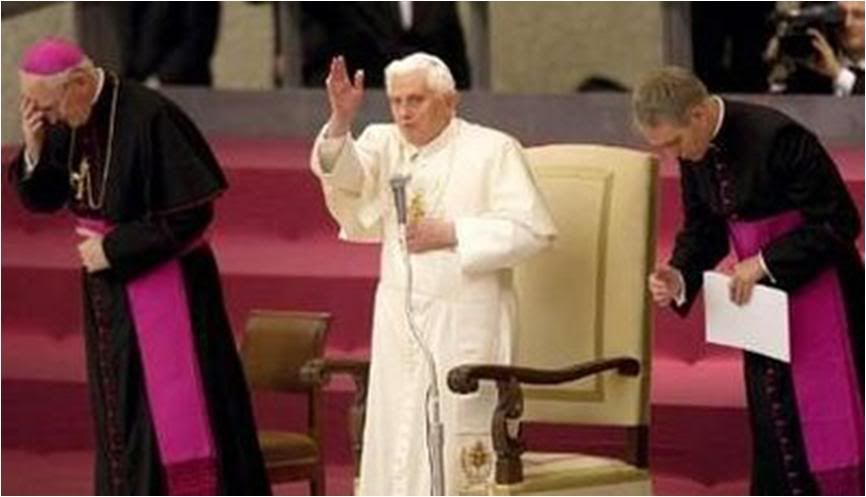
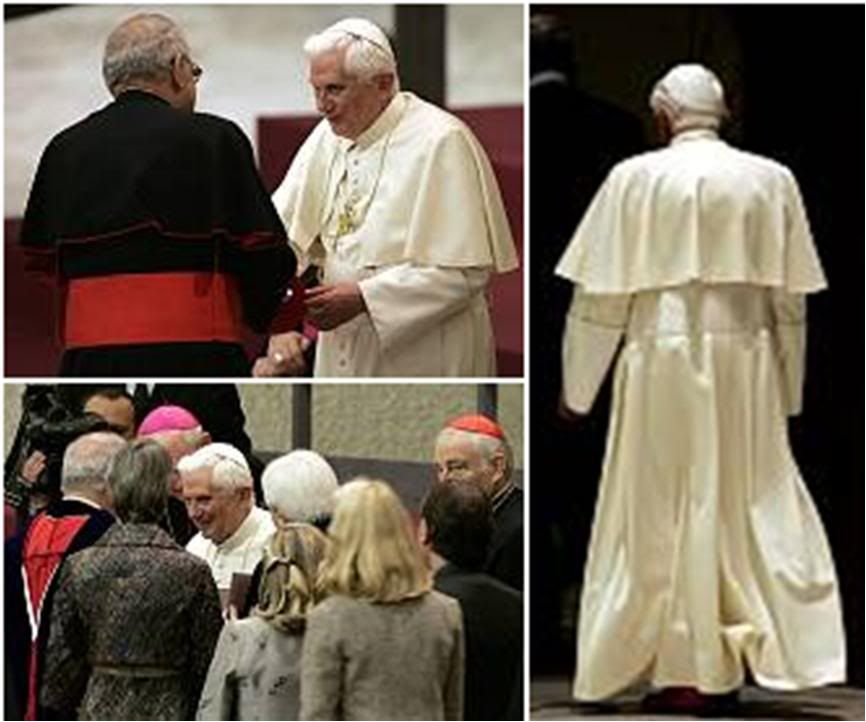
[Modificato da TERESA BENEDETTA 20/11/2009 01:17] |
| |
 19/11/2009 19:24 19/11/2009 19:24 |
|
| | | OFFLINE | | Post: 18.905
Post: 1.553 | Registrato il: 28/08/2005
Registrato il: 20/01/2009 | Administratore | Utente Veteran | |
|

 Struggling Anglican leader
Struggling Anglican leader
in Rome for papal talks
By NICOLE WINFIELD

ROME, Nov. 19 (AP) – The Archbishop of Canterbury sought Thursday to downplay the implications of the Vatican's unprecedented invitation for Anglicans to join the Catholic Church as he arrived in Rome for his first talks with the Pope on the new policy.
Archbishop Rowan Williams's three-day visit, which began Thursday with a lecture and ends Saturday with a papal audience, was scheduled before the Vatican announced it was making it easier for traditional Anglicans upset over the ordination of women and gay bishops to become Catholic.
The Vatican has said it was merely responding to the many Anglican requests to join the Catholic Church and has denied it was poaching for converts in the Anglican pond.
But the move has already strained Catholic-Anglican relations [How exactly????] and is sure to affect Williams's 77-million worldwide Anglican Communion, which was already on the verge of schism over homosexuality and women's ordination issues before the Vatican intervened.
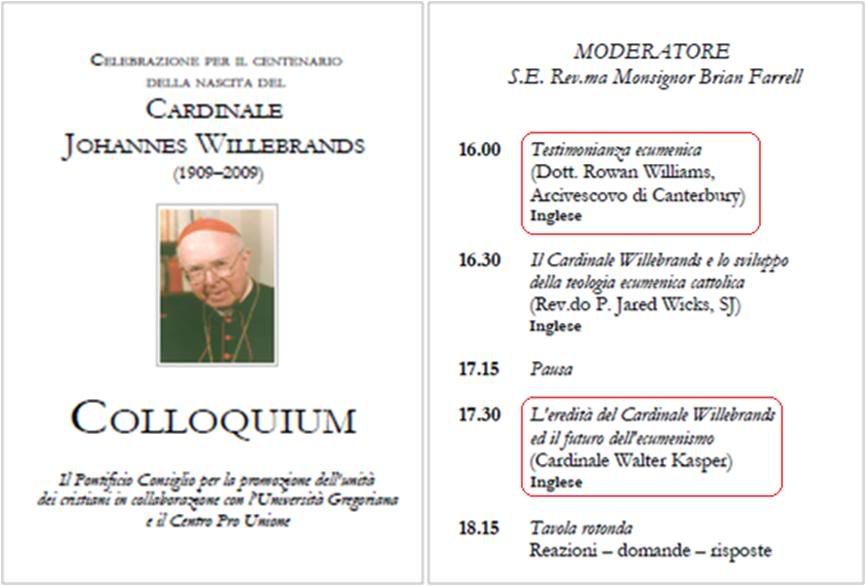 Williams's lecture was for a colloquium sponsored by the Pontifical Council for Christian Unity to mark the 100th birth anniversary of the late Cardinal Willebrnads, who was the first President of the Council.
Williams's lecture was for a colloquium sponsored by the Pontifical Council for Christian Unity to mark the 100th birth anniversary of the late Cardinal Willebrnads, who was the first President of the Council.
In a speech at the Pontifical Gregorian University in Rome, Williams was gracious in referring to the Vatican's new policy, which he called the "elephant in the room." The policy was an "imaginative pastoral response" to requests by some Anglicans but broke no new doctrinal ground, Williams said.
He spent the bulk of his speech describing the progress that had been achieved so far in decades of Vatican-Anglican ecumenical talks and questioning whether the outstanding issues were really all that great.
"The ecumenical glass is genuinely half full," the archbishop said.
The full text of the Archbishop's address is available on his site:
www.archbishopofcanterbury.org/2616
Anglicans split from Rome in 1534 when English King Henry VIII was refused a marriage annulment. For decades, the two churches have held theological discussions on trying to reunite, part of the Vatican's broader, long-term ecumenical effort to unify all Christians.
But differences remain and the ecumenical talks were going nowhere as divisions mounted between liberals and traditionalists within the Anglican Communion itself.
While acknowleging the outstanding differences with Rome, Williams suggested that a way forward might be to embrace a "diversity of types of communion," in which communion could be achieved but not with a "single juridically united body."
The Vatican official in charge of relations with Anglicans, Cardinal Walter Kasper, also sought to put a positive interpretation on the future, drawing a clear distinction between the doctrinal talks on unification and questions of conversion.
"We cannot close our doors when others knock on them. But this does not exonerate us from" pursuing the broader unification of the churches as institutions, he said in a speech to the Gregorian symposium.
The new policy allows Anglicans to convert to Catholicism but retain many of their Anglican liturgical traditions, including married priests. The Vatican will create the equivalent of new dioceses, so-called personal ordinariates, for these former Anglicans that will be headed by a former Anglican priest or bishop.
Estimates on the number of possible converts has ranged from a few hundred to thousands.
The new policy has elicited heated criticism in Britain, both in Anglican and Roman Catholic circles. Catholic theologian Nicholas Lash said it was "disgraceful" that the Vatican devised the policy without even consulting Catholic bishops, much less Anglican ones.
Williams, for example — the spiritual leader of the worldwide Anglican Communion — wasn't even informed of the change until right before it was announced.
Kasper referred to the criticism in his speech, saying that in the future issues of both conversion and ecumenism "should be undertaken in the greatest possible transparency, tactfulness and mutual esteem in order not to entail meaningless tensions with our ecumenical partners."
[The full text of Cardinal Kasper's presentation at the colloquium has been posted in the CHURCH&VATICAN thread, translated from the OR, which is publishing it in the 11/20 issue, as I cannot find the original English text online.]
One group that has cheered the new policy is the Traditional Anglican Communion (TAC), which split from the Anglican Communion in the early 1990s after the first women were ordained Anglican priests. The TAC, which has long sought to come under Rome's wing, says it has 400,000 members in 41 countries, although only about half are regular churchgoers.
Already, TAC's British province has voted to take Rome up on its invitation. TAC leader Archbishop John Hepworth has said he anticipates others will follow.
It remains to be seen how the new policy will affect Pope Benedict XVI's planned trip to Britain next year.
One thing is likely, however: The Vatican will surely hold out the upcoming beatification of the most famous Anglican convert, Cardinal John Henry Newman, as a symbol of bridge-building, since the 19th century theologian is a hero to many Anglicans and Catholics alike.
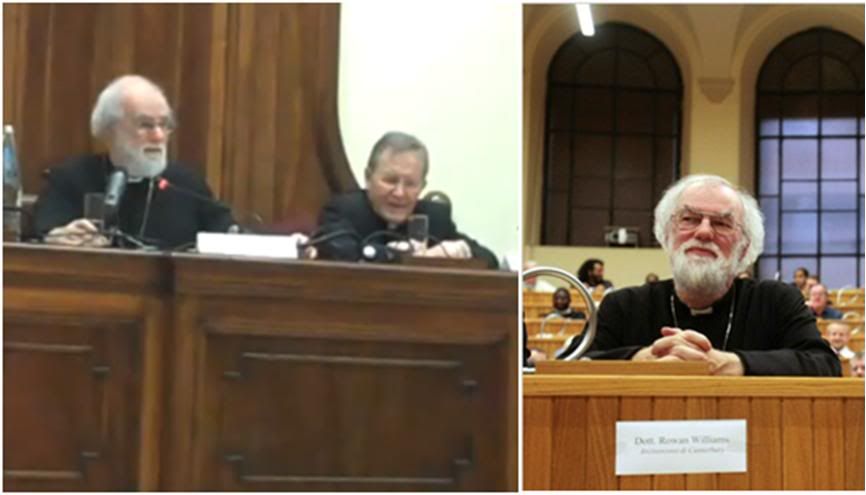 Archbishop Williams and Cardinal Kasper at the Colloquium.
Archbishop of Canterbury opens Rome visit
Archbishop Williams and Cardinal Kasper at the Colloquium.
Archbishop of Canterbury opens Rome visit
with a controversial statement
By Martin Beckford and Nick Squires

Nov. 19, 2009
ROME - Dr Rowan Williams, Archbishop of Canterbury and Primate of the Church of England, has challenged Catholic doctrine by claiming that even the dispute over whether women can be priests should not be a serious dividing issue between the two major Christian denominations.
He held up the Anglican Communion, which has been driven to the brink of collapse over homosexuality in recent years, as an example of how a family of churches can remain connected despite the differences between them.
The archbishop made his provocative comments at the Gregorian University in Rome, at a meeting to celebrate the centenary of Cardinal Willebrands, a former president of the Pontifical Council for Promoting Christian Unity.
It is Dr Williams’s first trip to Rome since the Vatican’s surprise announcement of a new way for groups of Anglicans disaffected by the liberal direction of the church to convert to Catholicism.
He will meet Pope Benedict XVI on Saturday to discuss the implications of the creation of Personal Ordinariates, which could see hundreds of thousands worldwide enter into full communion with Rome while retaining parts of their former Anglican heritage.
Dr Williams, who had no part in the development in the scheme and was only given two weeks’ notice of its announcement, described it as “the elephant in the room” during his address on Thursday afternoon.
He admitted it represented an “imaginative pastoral response to the needs of some” but insisted it did not “break any fresh ecclesiological ground”.
The archbishop, the most senior cleric in the Church of England, said that joint statements made by the Anglican and Catholic churches since the 1960s showed a “strong convergence” in ideas about what the Christian church is.
He admitted there remain areas where the denominations differ, such as on the position of the Pope and the ordination of women, but claimed they are not theological but “second order” issues.
“If the issues are less basic than the agreement over the Church’s central character, then the future ought to be one in which there is a search for practical convergence in administrative responsibility and visible structures of governance,” Dr Williams claimed.
Most controversially, he questioned the Catholic doctrine that only men can serve as priests and claimed churches that ordain women are able to remain in communion with those that do not.
He asked: “In what way does the prohibition against ordaining women so ‘enhance the life of communion’, reinforcing the essential character of filial and communal holiness as set out in Scripture and tradition and ecumenical agreement, that its breach would compromise the purposes of the Church as so defined?”
The archbishop pointed out that Anglican provinces could serve as a “possible model” for different denominations by showing how they can “maintain a degree of undoubtedly impaired communion” despite “sharp” divisions.
“Once again, I am asking how far continuing disunion and non-recognition are justified, theologically justified in the context of the overall ecclesial vision, when there are signs that some degree of diversity in practice need not, after all, prescribe an indefinite separation.”
He concluded that the “ecumenical glass is genuinely half-full” and that the “unfinished business” between the two denominations is not “as fundamentally church-dividing as our Roman Catholic friends generally assume and maintain”.
In London, the Archbishop of Westminster also had a reproach...
Churches head for a showdown in Rome
by Ruth Gledhill, Religion Correspondent

Nov. 19. 2009
The Archbishop of Westminster has blamed Church of England bishops for keeping their leader in the dark about the Pope’s attempts to entice Anglicans to Rome.
As the Archbishop of Canterbury prepared to visit Pope Benedict XVI for the first time since plans to admit Anglican opponents of women priests into the Catholic faith were published, the Most Rev Vincent Nichols, head of the Roman Catholic Church in England and Wales, deepened the row.
Archbishop Nicholls said that it had been the “duty” of the Anglicans involved in the talks to keep their primate informed about the Pope’s plans.
The Archbishop was defending the Pope against accusations of discourtesy after he failed to alert Dr Williams of the proposals for an Apostolic Constitution, or decree to set up a new Anglican ordinariate. The announcement was sprung on a distressed Dr Williams last month with barely two weeks’ notice.
In an interview with The Tablet, Archbishop Nichols declined to comment on the accusation from the Anglican Bishop of Southwark, Dr Tom Butler, who accused the Holy See of discourtesy in failing to consult Dr Williams.
Archbishop Nichols said: “While approaches had been made to the Holy See, I don’t think that had been conveyed to the Archbishop of Canterbury. Frankly it was the duty of the Anglicans to do that.”
The Apostolic Constitution, published by the Vatican this month, enables thousands of disaffected Anglicans to become Catholics. Married Anglican clergy will be allowed to train for the priesthood in seminaries set up within the new Anglican ordinariates. The admission of married men will be “on a case-by-case basis”.
It even allows for married Anglican bishops to be granted the status of retired Catholic bishops, to become members of the local Catholic bishops’ conference and to be allowed to use the “insignia” of episcopal office, such as the mitre, pectoral cross and staff.
Former Catholic priests who left the Church to marry and subsequently became Anglican clergymen will not be permitted to return. More than one in ten Church of England priests [And that is supposed to be a significant statistic? I would think it accounts for the natural rate of second thoughts that follow a major life-changing decision!] who converted to Roman Catholicism over the ordination of women priests have returned to ministry in the established Anglican Church, according to figures released to The Times.
Such priests have warned Anglican clergy against going over, with one saying that he had not been made welcome in Catholic churches.
A total of 441 clergy received compensation payments worth £27.5 million when they left the Church of England after the General Synod voted to ordain women priests in 1992. Of these, 260 went to the Catholic Church. Thirty-three have returned to stipendiary ministry in the Church of England. [It's just as likely their second thoughts had to do with economic considerations - the Catholic Church cannot pay its priests as much as the Church of England does.]
Senior Catholics sought yesterday to quash speculation that the Pope’s visit to Britain next September had been downgraded from a State to a pastoral visit because of the dispute over the new Anglican Ordinariate.
The Queen, who was expected to host the Pope at Buckingham Palace, made no mention of a Papal visit in the Queen’s Speech yesterday. A Church source said that this was because the visit was not due to take place until the end of next year. Downing Street declined to comment.
[Modificato da TERESA BENEDETTA 20/11/2009 21:10] |
| |
 19/11/2009 21:25 19/11/2009 21:25 |
|
| | | OFFLINE | | Post: 18.906
Post: 1.554 | Registrato il: 28/08/2005
Registrato il: 20/01/2009 | Administratore | Utente Veteran | |
|

 Benedict XVI:
Benedict XVI:
The realist on hunger
Translated from

Nov. 19, 2009
Last week Benedict XVI, meeting the members of the Pontifical Council Cor Unum, told them: "The Church cannot be detached from the concrete life conditions of men".
His participation in the FAO world summit on food security must be seen in this light. His encyclical Caritas in veritate and the recent Synodal Assembly on Africa (even if it was 'hidden' in media silence) have demonstrated how much the Church is capable of lucidity and concreteness in dealing with what afflicts humanity.
It is not a question of having expert analysts or super-technicians. The clarity has a precise source: 'the faith' as "a spiritual force that purifies reason in the search for a just order".
And that is why at FAO, the Pope urged the politicians to look even deeper, namely, that brotherly solidarity, even if it must rely on technology, on laws and on institutions, "should not exclude the religious dimension (which is) capable of recognizing the transcendent value of every man and every woman" - and that indeed, 'conversion of the heart' - which is the only impulse that can change the world - depends on such a recognition.
The culture of 'making things work' has accustomed us to reducing any problem to a technical question. Faith is considered irrelevant4.
But the more we make progress, with ever more instruments, the more we find ourselves faced with the same fundamental problems unresolved.
Benedict XVI asks us to be open to the fundamental questions because it is precisely this technological illusion that obscures realism. As the saying goes, he who can look up to the heavens knows well how to keep his feet firmly on the ground.
|
| |
 20/11/2009 12:33 20/11/2009 12:33 |
|
| | | OFFLINE | | Post: 18.908
Post: 1.556 | Registrato il: 28/08/2005
Registrato il: 20/01/2009 | Administratore | Utente Veteran | |
|
 Friday, November 20
Friday, November 20
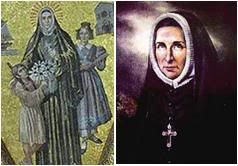 ST. ROSE PHILIPPINE DUCHESNE (b France 1769, d USA 1852)
ST. ROSE PHILIPPINE DUCHESNE (b France 1769, d USA 1852)
Nun, Mother Superior and Missionary
Born to an aristocratic family in Grenoble, she became a Visitation nun
and did charitable work for 9 years following the French Revolution.
When her convent closed, she joined the Sisters of the Sacred Heart
and at age 49, was sent as a missionary to the United States, where
she had hoped to work with native Americans. She and her sisters
set up schools in Missouri and Louisiana. She was 72 when she was
finally assigned to work with an Indian tribe. Mother Duchesne was
87 when she died. She was canonized in 1988.
OR today.
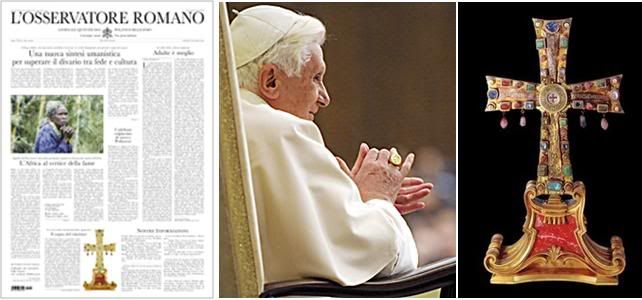
The Pope asks Catholic universities to serve truth and to dialog with other fields of knowledge:
'A new humanistic synthesis to overcome the divergence between faith and culture'
Other Page 1 stories: The Vatican's most precious reliquary, the Crux Vaticana, with a piece of Christ's Cross, has been
restored and is on display till April 10 next year; an essay by the president of the pontifical Academy for Life summarizing
current evidence that adult stem cells are much more promising than embryonic cells; an article on the hunger situation in
Africa; and new Taliban terror bombings in Afghanistan. The inside pages contains the lecture by Cardinal Walter Kasper
[translated and posted in the CHURCH&VATICAN thread) on the future of ecumenism, one of three articles to mark the
100th birth anniversary of his predecessor, Dutch Cardinal Johannes Willebrands, one of the great pioneers of ecumenism
after Vatican-II.
THE POPE'S DAY
The Holy Father met today with
- H.E. Runaldo Ronald Venetiaan, President of the Republic of Surinam, with his wife and delegation
- H.E. Mons. Luigi Ventura, Apostolic Nuncio in France
- Bishops of Brazil (South Sector I), on ad limina visit
- Participants eof the International Conference organized by the Pontifical Council for the Pastoral Care
of Healthcare Givers. Address in Italian.
And this afternoon, with
- Cardinal Ivan Dias, Prefect of the Congregation for the Evangelization of Peoples
[Modificato da TERESA BENEDETTA 20/11/2009 18:17] |
| |
 20/11/2009 12:54 20/11/2009 12:54 |
|
| | | OFFLINE | | Post: 18.909
Post: 1.557 | Registrato il: 28/08/2005
Registrato il: 20/01/2009 | Administratore | Utente Veteran | |
|
 Ahead of his meeting with artists tomorrow,
Ahead of his meeting with artists tomorrow,
Pope Benedict discusses 'the way of beauty'
towards God in his Wednesday catechesis
He dedicated his lecture to the Romanesque and Gothic cathedrals of the Middle Ages to explain that
"beauty is the most fascinating way to draw near to the mystery of God"

ROME, November 20, 2009 – Tomorrow, in the Sistine Chapel, Benedict XVI will meet with hundreds of artists from all over the world, believers and nonbelievers. There is great anticipation over what he will say.
But on Wednesday, November 18, in the catechesis that he gives each week to the faithful, he provided a sneak peek.
The coincidence in the timing didn't go unnoticed. After describing, in the previous catecheses, the events and personalities of medieval theology, Papa Ratzinger decided to illustrate – three days before the meeting with artists – those masterpieces of art and faith which are the Romanesque and Gothic cathedrals, which after the year 1000 covered Europe "with the white garments of new churches."
The first lesson that Benedict XVI drew from this is that Christian art and faith evoke one another, "because both can and intend to speak of God, making the Invisible visible."
The second lesson is that beauty is "the most attractive and fascinating way to come to encounter and love God."
These are issues to which Ratzinger, as theologian and pastor, has always been extremely sensitive.
But for a more intimate understanding of his thought, it is helpful to look back at what he said, speaking off the cuff, to the priests of the diocese of Bressanone with whom he met in the summer of 2008.
It has become routine to think about Benedict XVI as the pope of the "Logos." His critics accuse him of rationalism. But in reality, he is convinced that Christianity's "proof of truth" does not come solely by rational means. For him, "art and the saints are the greatest apologia of our faith."
This, in fact, is what he said in this regard on that August 6, the feast of the Transfiguration of Jesus, to the priests of Bressanone:
The arguments presented by reason are absolutely important and indispensable, but there always remains some disagreement somewhere. If, instead, we look at the saints, this great luminous arc that God has set across history, we see that here there is truly a power of goodness that lasts over the millennia, here there is truly light from light.
And in the same way, if we contemplate the created beauties of the faith, these simply are, I would say, the living proof of faith. [...] All of the great works of art, the cathedrals – the Gothic cathedrals, and the splendid Baroque churches – all of them are a luminous sign of God, and therefore truly a manifestation, an epiphany of God. [...]
We have just listened to the sound of the organ in all its splendor, and I think that the great music born within the Church is an audible and perceptible rendering of the truth of our faith: from Gregorian chant to the music of the cathedrals to Palestrina and his era, to Bach and then to Mozart and Bruckner, and so on...
Listening to all of these great works – the Passions by Bach, his Mass in B minor, and the great spiritual compositions of 16th century polyphony, of the Viennese school, of all of this music, even by minor composers – suddenly we feel: it is true! Wherever things like these are created, there is Truth. [...]
Christian art is a rational form of art – we think of Gothic art, great music, or the Baroque art right here – but this is the artistic expression of a much broader form of reason, in which the heart and reason come together. This is the point.
This, I think, is in some way the proof of the truth of Christianity: the heart and reason come together, beauty and truth touch. And to the extent that we are able to live in the beauty of truth, so much more will faith again be able to be creative, in our own time as well, and to express itself in a convincing artistic form.
[Magister then provides an English translation of the Pope's Nov. 18 catechesis, for which I posted my translation on this thread on the day of the catechesis.]
What came before
tomorrow's meeting
Translated from
the Italian service of

The much-awaited meeting between Benedict XVI and artists at the Sistine Chapel tomorrow takes place on the tenth anniversary of John Paul II's Letter to Artists, and 45 years after the historic meeting of Paul VI with the world of art in May 1964.
The event is intended to renew the friendly relations between the Church and artists, and inspire new opportunities to work together. Fabio Colagrande reports:
The chapel decorated by Michelangelo was the site, almost half a century ago, of a meeting between a Pontiff and the world of art.
Papa Montini, following initiatives begun by his predecessors Pius XII and John XXIII, wanted it to be an occasion for a 'reconciliation':
I must say the words which you already know: We need you! Our ministry needs your collaboration. If you will allow me to say it, you have abandoned us, you have gone far away to drink at other fountains... We acknowledge that we too erred. because we imposed a limitation to begin with, like a lead shield...
Can we now say, Forgive us? Shall we make peace? Today and here, we wish to be friends again. Let the Pope become, once again, a friend to artists. We should go back to being allies.
It is in the wake of these vibrant words by Paul VI, reiterated the following year in a message to artists at the closing of Vatican-II, and also in the letter signed by John Paul II in 1999, that the Saturday meeting with Benedict XVI takes place.
Among the 260 artists who accepted the invitation from the Pope and the Pontifical Council for Culture, is Italian poet Roberto Mussapi:
I think it is a reciprocal need insofar as the most important artists today, those to whom I feel close - and they include painters and film directors, for instance - have a strong metaphysical urge which represents a reversal of the nihilist sensibility that prevailed in the early decades of the 20th century. Their contribution is fundamental.
But they also need to see a church that is immersed in an artistic experience, the incarnation of art in the Christian religion. Poetry, for instance, seems a metaphor for incarnation itself, as the expression in historical cultural form of questions that are beyond time and supernatural.
It is difficult to say who would benefit more from a revitalization of the collaboration between artists and the Church. Both could certainly benefit, as another poet says who will be at the Sistine Chapel tomorrow, Davide Rondoni [who is also an editorial writer for Avvenire]:
Surely, it is the artist who will benefit more from the relationship between art and faith - the artist who finds in faith not so much a complement to art as though art has to be done in faith, but rather, the possibility of always seeing that which Arturo Martini, the greatest Italian sculptor last century, called 'the fourth dimension' the dimension of mystery - in everything he saw.
Perhaps today the Church can become more attentive to the artistic formation of its own priests, to humanistic formation in its seminaries....
I was always struck by something Don Giussani [founder of Communione e Liberazione], who was a good friend, liked to say - that as a boy, when he went to receive Communion, he would recite the verses of Leopardi [one of Italy's greatest 19th-century poets, Romantic and pessimistic] because either Jesus had an answer to Leopardi's questions, or Jesus Christ meant nothing at all.
Perhaps, it is necessary to widen this kind of sensibility, this type of attention to art as a patrimony of an experience of faith.
I checked up John Paul II's 1000 Letter to Artists, and it is 12 printed pages long, so here's the link to the English text:
www.vatican.va/holy_father/john_paul_ii/letters/documents/hf_jp-ii_let_23041999_artists...
Paul VI had two specific addresses to artists - the first was his homily at a Mass for Artisis he celebrated in the Sistine Chapel on May 6, 1964, on the Feast of the Asecension, and it is available on the Vatican website only in Italian.
www.vatican.va/holy_father/paul_vi/homilies/documents/hf_p-vi_hom_19640507_messa-artisti...
The second was a portion of his closing address for the Second Vatican Council on December 9, 1965, as follows, in the Vatican translation to English:
We now address you, artists, who are taken up with beauty and work for it: poets and literary men, painters, sculptors, architects, musicians, men devoted to the theater and the cinema.
To all of you, the Church of the council declares to you through our voice: if you are friends of genuine art, you are our friends.
The Church has long since joined in alliance with you. You have built and adorned her temples, celebrated her dogmas, enriched her liturgy. You have aided her in translating her divine message in the language of forms and figures, making the invisible world palpable.
Today, as yesterday, the Church needs you and turns to you. She tells you through our voice: Do not allow an alliance as fruitful as this to be broken. Do not refuse to put your talents at the service of divine truth. Do not close your mind to the breath of the Holy Spirit.
This world in which we live needs beauty in order not to sink into despair. It is beauty, like truth, which brings joy to the heart of man and is that precious fruit which resists the wear and tear of time, which unites generations and makes them share things in admiration. And all of this is through your hands.
May these hands be pure and disinterested. Remember that you are the guardians of beauty in the world. May that suffice to free you from tastes which are passing and have no genuine value, to free you from the search after strange or unbecoming expressions.
Be always and everywhere worthy of your ideals and you will be worthy of the Church which, by our voice, addresses to you today her message of friendship, salvation, grace and benediction.
[Modificato da TERESA BENEDETTA 21/11/2009 00:18] |
| |
 20/11/2009 19:06 20/11/2009 19:06 |
|
| | | OFFLINE | | Post: 18.911
Post: 1.559 | Registrato il: 28/08/2005
Registrato il: 20/01/2009 | Administratore | Utente Veteran | |
|
 Benedict XVI relocates charity
Benedict XVI relocates charity
from the margins to the center of
social and political activities

BRESCIA, Nov. 20 (Translated from AGI) - With his encylical Caritas in veritate, Benedict XVI "has rejected the reduction of charity to the sentimental and therapeutic", which makes it marginal, and instead places it "at the center of social relationships, indeed at the heart of social and political action".
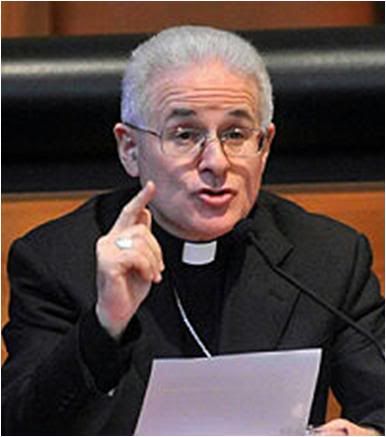
Thus said Mons. Mariano Crociata, secretary-general of the Italian bishops' conference (CEI), in a lectio magistralis at the local campus of the Catholic University of Sacro Cuore.
"This relocation to the center," he said, "expresses the truth of charity, and comes about through the realignment of the relatinship between justice and charity", in the belief that "economic, social and poltical development, if they are to be authentically human, must make room for the principle of gratuity as an expression of brotherhood".
Mons. Corciata said this is "a nerve center of the Encyclical, which frontally opposes the typical dissociation, almost taken for granted, of justice from conscience" in which "charity is considered to be entirely dependent on the individual and cannot be demanded of anyone".
Thus, he said, the Holy Father calls on us to redeem charity from its supposed marginality and relegation to individual conscience, so that it may be publicly affirmed and recognized, along with the corresponding policies [to facilitate its practice].
The encyclical, Mons. Crociata pointed out, "charity is not limited to caring for the poor and assisting the needy, but it must inform the constitutive dimension itself of social existence and configure the collective ethos... thus overcoming the individualistic scheme of social construction".
|
| |
 20/11/2009 22:11 20/11/2009 22:11 |
|
| | | OFFLINE | | Post: 18.912
Post: 1.560 | Registrato il: 28/08/2005
Registrato il: 20/01/2009 | Administratore | Utente Veteran | |
|
 WITH THE PRESIDENT OF SURINAM
WITH THE PRESIDENT OF SURINAM

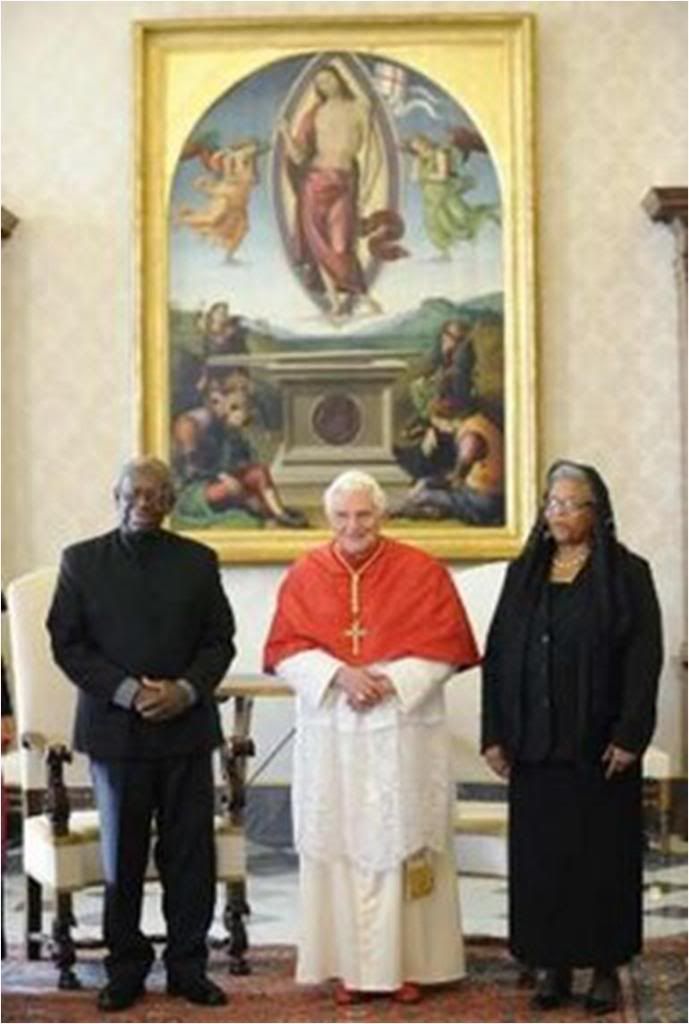
This morning in the Vatican Apostolic Palace Runaldo Ronald Venetiaan, president of the Republic of Surinam, was received in audience by His Holiness Benedict XVI.
The president subsequently went on to meet with Cardinal Secretary of State Tarcisio Bertone S.D.B. who was accompanied by Archbishop Dominique Mamberti, secretary for Relations with States.
The cordial meetings provided an opportunity for a fruitful exchange of opinions on questions concerning the current international and regional situation.
Attention then focused on certain aspects of the situation in Suriname, in particular on the social policies being introduced by the government, on the defence of the environment and on fields of collaboration between Church and State.
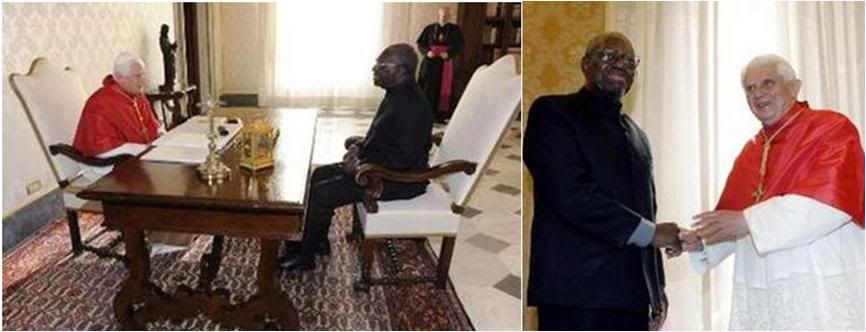
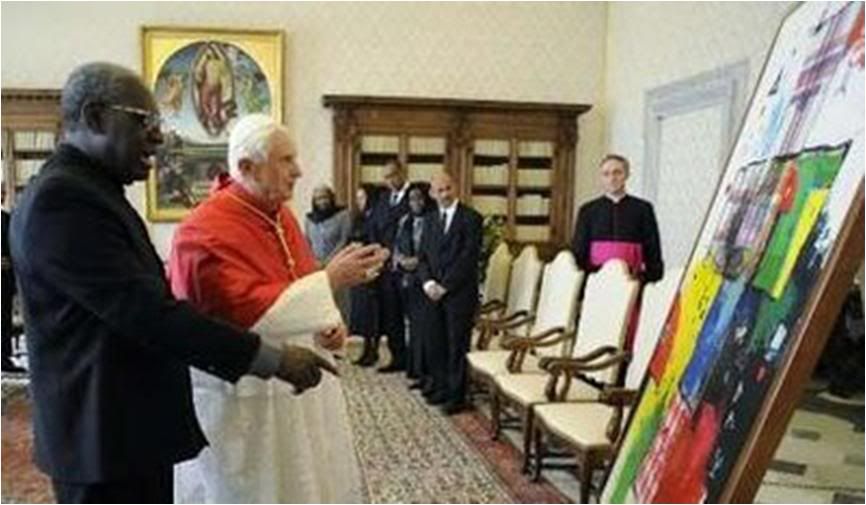
|
| |
 21/11/2009 14:00 21/11/2009 14:00 |
|
| | | OFFLINE | | Post: 18.913
Post: 1.561 | Registrato il: 28/08/2005
Registrato il: 20/01/2009 | Administratore | Utente Veteran | |
|
 Pope says humanity must be healed
Pope says humanity must be healed
of spiritual deafness

VATICAN CITY, NOV. 20, 2009 (Zenit.org).- Humanity needs to be saved from spiritual deafness, which blocks out the voices of God and one's neighbor, Benedict XVI says.
The Pope used this metaphor when he spoke today to participants in an international conference sponsored by the Pontifical Council for Health Care Ministry.

The event's theme was "Effata: the Deaf Person in the Life of the Church," and it aimed to consider ways in which the Church could better serve some 1.3 million Catholic deaf people.
Here is a translation of the Holy Father's full address to the Congress participants:
Dear brothers and sisters!
I am happy to meet you on the occasion of the XXIV International Conference organized by the Pontifical Council for Ministry to Health Care Workers on a topic that is of great social and ecclesial significance: "Effata: Deaf persons in the life of the Church".
I greet the president of the dicastery, Archbishop Zygmunt Zimowski, and I thank him for his kind words. I also greet the Secretary and the new Undersecretary, the priests, religious, laymen, experts and all who are present.
I wish to express my appreciation and encouragement for the generous commitment you have made to this important sector of the pastoral ministry.
Indeed, there are numerous sensitive problems that concern persons with hearing impairment, who have been the object of attentive reflection these days. It is a well-defined reality whose horizons range from the sociological to the pedagogical, from the medical and psychological to the ethico-spiritual and pastoral.
The relationships among the various specialists, the exchange of experiences among those who work in this sector, the testimonies of the deaf persons themselves, have offered the opportunity for a deep analysis of the situation and for proposals and indications for an increasingly appropriate attention to these brothers and sisters.
The word 'Effata!' - "Be opened!" - which begins the title of the Conference, calls to mind the famous episode from the Gospel of Mark (cfr 7,31-37), which constitutes a paradigm of how the Lord operates towards deaf persons.
Jesus takes aside a deaf-mute person, and after performing some symbolic gestures, he raises his eyes to Heaven and says: "Effata!", bee opened! Instantly, the evangelist says, the man's hearing was restored, his tongue was loosed, and he started speaking correctly.
Jesus's gestures are full of loving care and express profound compassion for the man before him: he shows him his concrete interest, he takes him apart from the confusion of the crowd, he makes him feel his closeness and understanding through gestures dense with significance.
He places his fingers in the man's ears, and with his saliva, he touches the man's tongue, then invite hims to join him in turning his interior gaze, that of the heart, towards the heavenly FAther. Finally, he heals him and restores him to his family, to his people. And the crwod, amazed, cannot but exclaim: "He has done all things well. He makes the deaf hear and the mute speak" (Mk 7,37).
With his behavior, which reveals the love of God the Father, Jesus does not only heal physical deafness, but indicate that there exists another form of deafness of which humanity must be cured, from which it should be saved: it is the deafness of the spirit, which raises ever higher barriers to the voice of God and our neighbor, especially to the cry for help of the least among them and of those who suffer, and which encloses man in a profound and ruinous selfishness.
As I had the occasion to point out in my homily during the pastoral visit to the Diocese of Viterbo in September 2007, "We can see in this sign the ardent desire of Jesus to defeat in man the solitude and incommunicability created by selfishness, to give face to a a 'new humanity', the humanity of listening and words, of dialog, of communication, of communion with God.
A good humanity, as all of God's creation is good; a humanity without discrimination, without exclusions... so that the world may truly be, for everyone, 'a field of genuine fraternity".
Unfortunately, experience does not always attest to diligent acceptance, to a conviction of solidarity and to warm communion with people who are hearing-impaired.
The numerous associations, which were born to protect and promote their rights, prove the existence of a never-stifled culture marked by prejudice and discrimination. These are attitudes that are deplorable and unjustifiable because they are contrary to respect for the dignity of deaf persons and their full social integration.
Much vaster, though, are the initiatives promoted by institutions and associations, both in the ecclesial as well as civilian fields, inspired by an authentic and generous solidarity, who have brought an improvement in the conditions of life for many deaf persons.
In this respect, it is significant to remember that the first schools for instruction and religious formation of these brothers and sisters of ours emerged in Europe as early as the 18th century. Since then, such charitable works have multiplied in the Church under the impulse of priests, religious and laymen with the purpose of offering deaf people not just formation but also integral assistance for full self-realization.
However, it is not possible to forget the serious situation in which they continue to live today in developing nations, either from the lack of appropriate policies and legislation, or from the difficulty to have access to primary health care. Deafness, in fact, is often a consequence of illnesses that are easily curable.
Therefore, I appeal to political and civilian authorities, as well as to international organisms, to offer the necessary support for promoting, in the developing nations, respect for the dignity and rights of dead persons, and to favor, with adequate assistance, their full social integration.
The Church, following the teaching and example of her divine Founder, continues to accompany the diverse pastoral and social initiatives for their benefit with love and solidarity, reserving special attention for those who suffer, in the awareness that a special strength lies hidden in suffering which brings man nearer to Christ - a special grace.
Dear brothers and sisters who have hearing problems, you are not just destinatories of the evangelical message, but you are yourself fully entitled announcers of the Gospel by virtue of your Baptism.
Therefore, live every day as witnesses to the Lord in the fields of your existence, making Christ and his Gospel known. In this Year for Priests, pray also for vocations, that the Lord may inspure numerous and good ministers for the growth of the ecclesial communities.
Dear friends, I thank you for this meeting and I entrust all of you present here to the maternal protection of Mary, Mother of love, Star of hope, Madonna of silence. With these wishes, I impart the Apostolic Blessing, which I extend to your families and all the associations actively working in the service of the hearing-impaired.
In his weekly column in which this week he points out two under-noticed and under-reported Catholic news stories this week, John Allen also refers to the Vatican's concern for deaf people. I've omitted his introductory paragraphs about baseball.
Rethinking the Catholic 'box score'

Nov. 20, 2009
...As I've observed before, Catholicism and baseball share a natural affinity. Both venerate the past, both spawn vast bodies of rules and lore, and both put a premium on patience. The analogy applies here too: In the church as on the diamond, flawed categories skew perceptions of the game.
A Catholic version of Moneyball might offer two challenges to the ecclesiastical box score:
•Thinking not just in local or national terms, but globally.
•Focusing not just on controversy, scandal, and newspaper headlines, but where ordinary Catholics actually invest their time and treasure.
Two stories this week illustrate each point.
In Mexico, the country's bishops issued a cri de Coeur Nov. 12, in the wake of 14,000 violent deaths since a crackdown on drug cartels began in 2006: "To the producers, dealers, pushers and consumers, we say, 'Enough!' Stop hurting yourself, and stop causing so much damage and pain to our young people, to our families and to our country."
The bishops also apologized for "superficial evangelization," and what they euphemistically described as an "anti-witness from many of the baptized." That's an indirect way of admitting that in a country where 90 percent of the population is nominally Catholic, such carnage would be impossible if Catholics weren't complicit.
All this took some guts, since denouncing the drug trade can be hazardous to one's health. Fifteen Catholic clergy have been murdered in Mexico since 1993, including a cardinal, eleven diocesan priests, and three religious.
In 2008 alone, seven bishops and 120 priests received death threats, placing the priesthood alongside journalism and law enforcement as dangerous occupations. Most of these attacks remain unsolved, due to intimidation and corruption.
Mexico is the second-largest Catholic country on earth, and it's an example of realities across the developing world, where two-thirds of the 1.1 billion Catholics today live. This week's news illustrates three frequently under-appreciated points about the church:
•Catholics elsewhere usually don't spend much time on the debates that loom so large in Europe and the States, such as the Latin Mass or the power of the bishops. Given the challenges they're facing, such preoccupations often seem a luxury they can't afford.
•The most creative Catholic energies in the 21st century are likely to be ad extra rather than ad intra, concerned with changing the world rather than changing the church.
•The dominant Catholic social justice concern of the future is likely to be good governance and the fight against corruption. As a result, the "growth industry" in peace-and-justice ministry will likely be personal conversion, not just political advocacy.
The second story is even less likely to make waves, but it's equally revealing: From Nov. 19-21, the Vatican is holding a first-ever conference on ministry to the deaf. The event was presented by the Pontifical Council for Health Pastoral Care, and organized by groups such as the International Catholic Foundation for the Service of Deaf Persons and an Italian religious order called "The Little Mission for the Deaf."
On Tuesday, Archbishop Zygmunt Zimowski, President of the Pontifical Council, estimated that there are 1.3 million deaf Catholics around the world -- many of whom, he admitted, struggle to "participate fully" in the church, "with consequent obstacles to their possibilities for spiritual growth and religious practice." That marginalization, Zimowski said, represents "a loss of their contribution to the vitality and riches of the church."
Ministry to the deaf is a relatively new pastoral category, and it's emerged as creative impulses usually do, from ordinary Catholics seeing a need and trying to meet it. Officialdom is simply ratifying something already bubbling at the grassroots.
If you want a measure of how over-emphasis on a limited set of categories distorts perceptions, consider this: Barrels of ink have been spilled dissecting the Vatican's outreach to disgruntled Anglicans, which, realistically, might bring a few thousand new members into the church worldwide.
Here you have an effort to integrate 1.3 million folks more thoroughly into the church, and it flies below radar -- because, of course, ministry to the deaf doesn't open a new front in the culture wars, which is a category we in the West take very seriously indeed.
This week's conference also helps account for something that otherwise can seem inexplicable: Why so many Catholics remain basically bullish about the church, despite all the scandal, division, and disappointment. Such Catholics aren't in denial, but their energy is invested in trying to do something positive.
When hope is what gets you out of bed in the morning, the landscape almost always looks more promising. In parishes, lay movements, schools, and other Catholic venues all over the world, that's still the case, even if it rarely attracts much notice.
Perhaps all this could be the basis of a new "box score" for the Church, meaning a better set of categories for thinking about what really matters. If Sabermetrics can help the Red Sox break the Bambino's curse (and I say this as a diehard Yankees fan), its potential for generating winning strategies in Catholic life may well be almost unlimited.
[Modificato da TERESA BENEDETTA 23/11/2009 13:52] |
| |
 21/11/2009 14:01 21/11/2009 14:01 |
|
| | | OFFLINE | | Post: 18.914
Post: 1.562 | Registrato il: 28/08/2005
Registrato il: 20/01/2009 | Administratore | Utente Veteran | |
|
 Saturday, November 21
Saturday, November 21
 FEAST OF THE PRESENTATION OF MARY
FEAST OF THE PRESENTATION OF MARY
The apocryphal Proto-Evangelium of James recounts that the girl Mary was consecrated to God by her parents Joachim and Anna, in thanksgiving for having the child after long years of barrenness. First celebrated in 6th century Jerusalem, the feast is one of the 12 major feasts in the Greek Orthodox liturgy, where it is formally known as 'the entry of the all-Holy Theotokos (God-bearer) into the temple'. It became a Catholic feast in the 16th century, emphasizing Mary's holiness from the start of her life - the one human being destined to be a living temple of God, 'greater than any temple built by man'.
OR today.
 Illustration: Presentation of Mary, from the Menology of Basil II, 10th century.
The issue commemorates today's liturgical feast with an article on 'The girl in whom God dwelt', the latest in a series about the great feasts common to the Catholic and Orthodox Churches. Other Page 1 stories: the Holy Father's audience with the President of Surinam, and his address to participants in a Curial conference for healthcare workers focused on the needs of deaf people; a situationer on Afghanistan and Pakistan as hostage to the Taliban; a UNICEF report claiming that educational conditions have improved for most of the world's children, but that 150 million children aged 5-14 are being exploited in child labor. In the inside pages, a number of articles on cloistered orders, on the occasion of the World Day today for contemplatives dedicated to prayer.
THE POPE'S DAY
Illustration: Presentation of Mary, from the Menology of Basil II, 10th century.
The issue commemorates today's liturgical feast with an article on 'The girl in whom God dwelt', the latest in a series about the great feasts common to the Catholic and Orthodox Churches. Other Page 1 stories: the Holy Father's audience with the President of Surinam, and his address to participants in a Curial conference for healthcare workers focused on the needs of deaf people; a situationer on Afghanistan and Pakistan as hostage to the Taliban; a UNICEF report claiming that educational conditions have improved for most of the world's children, but that 150 million children aged 5-14 are being exploited in child labor. In the inside pages, a number of articles on cloistered orders, on the occasion of the World Day today for contemplatives dedicated to prayer.
THE POPE'S DAY
The Holy Father met today with
- The Archbishop of Canterbury, Dr. Rowan Williams, and his delegation
_ Artists invited to the Sistine Chapel. Address in Italian.
And in the afternoon with
- Cardinal Giovanni Battista Re, Prefect of the Congregation for Bishops (weekly meeting)
[Modificato da TERESA BENEDETTA 21/11/2009 16:00] |
| |
 21/11/2009 14:08 21/11/2009 14:08 |
|
| | | OFFLINE | | Post: 18.915
Post: 1.563 | Registrato il: 28/08/2005
Registrato il: 20/01/2009 | Administratore | Utente Veteran | |
|

 THE POPE AND ARCHBISHOP WILLIAMS:
THE POPE AND ARCHBISHOP WILLIAMS:
First meeting after
'Anglicanorum coetibus'

Nov. 21, 2009
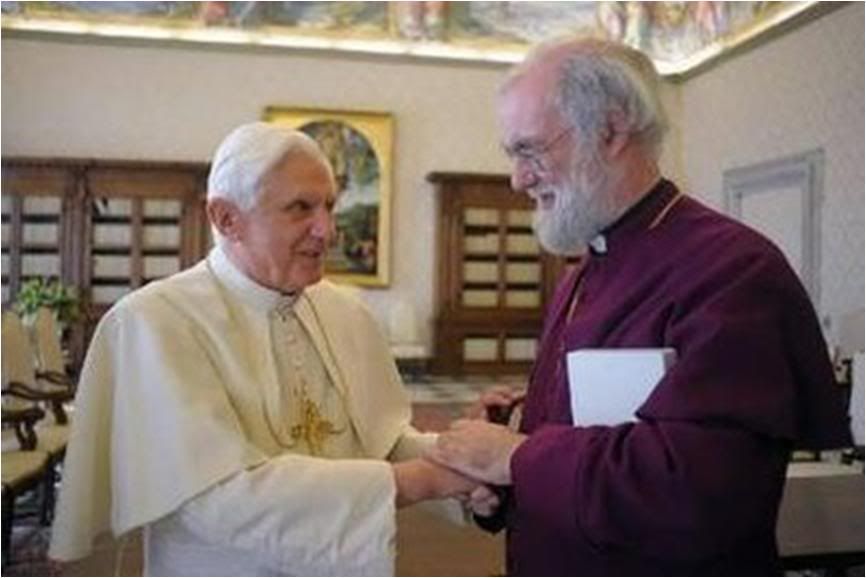

This morning His Holiness Pope Benedict XVI received in private audience His Grace Rowan Williams, Archbishop of Canterbury.
In the course of the cordial discussions attention turned to the challenges facing all Christian communities at the beginning of this millennium, and to the need to promote forms of collaboration and shared witness in facing these challenges.
The discussions also focused on recent events affecting relations between the Catholic Church and the Anglican Communion, reiterating the shared will to continue and to consolidate the ecumenical relationship between Catholics and Anglicans, and recalling how, over coming days, the commission entrusted with preparing the third phase of international theological dialogue between the parties (ARCIC) is due to meet.
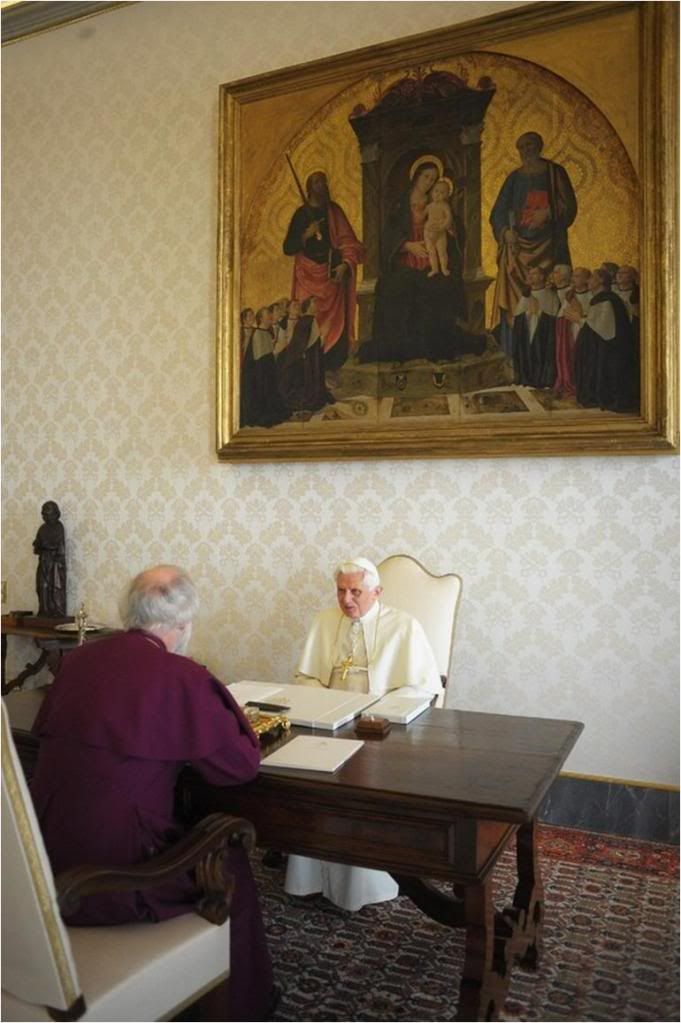
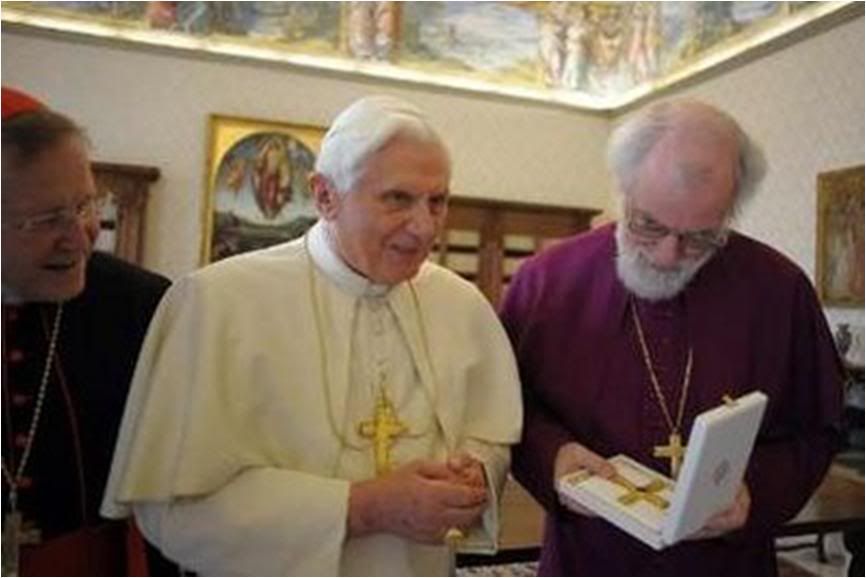 Anglican leader meets Pope
Anglican leader meets Pope
amid tensions
by Gina Doggett

VATICAN CITY. Nov. 21 (AFP) – Pope Benedict XVI and his Anglican counterpart, Archbishop of Canterbury Rowan Williams, had "cordial discussions" on Saturday, the Vatican said amid tensions between the two churches.
The strictly private meeting came just two weeks after the Vatican made it easier for disgruntled Anglicans to convert to Catholicism, a move that caught Williams off-guard, saying he had been informed of it "at a very late stage."
The two leaders "focused on recent events affecting relations between the Catholic Church and the Anglican Communion," the Vatican said in a statement, adding that they vowed to "continue and to consolidate the ecumenical relationship."
"Attention turned to the challenges facing all Christian communities at the beginning of this millennium, and to the need to promote forms of collaboration and shared witness in facing these challenges," the brief statement said.
The press has painted Williams's visit, though scheduled long before the controversy, as a "showdown" between the two churches, but observers expected a show of unity.
The Vatican's new framework for Anglicans to become Roman Catholics "is not going to halt ecumenical progress," said Reverend Doctor R. William Franklin, associate director of the American Academy in Rome.
"People are saying they are not being prevented from going forward," he told AFP.
The two church leaders will "want to demonstrate good will and show that ecumenism is going forward on other issues," agreed veteran Vatican watcher Bruno Bartoloni, referring to theological questions and the issue of papal primacy.
The Vatican unveiled on November 9 what was described by The Times of London as "potentially the most explosive development in Anglican-Catholic relations since the Reformation."
The move, which could attract hundreds of Anglicans from around the world who oppose women and openly gay clergy, was a response to what the Holy See called "repeated and insistent" petitions.
"What has happened in reality is that both sides have recognised that ecumenism has failed," Bartoloni told AFP. "The Catholic Church has made clear that they will never agree on the question of women priests and bishops."
As a result, he said: "The Anglican reactionaries will go over to the Catholic Church. It actually suits both sides."
At a conference at Rome's Gregorian University on Thursday, Williams spoke of the "ecumenical glass (being) genuinely half-full" while acknowledging they had "unfinished business" to resolve.
The event "did a lot to help defuse the situation," said Franklin, who is also an academic fellow at the Anglican Centre in Rome.
While appearing conciliatory, Williams also laid down what he called a "challenge to recent Roman Catholic thinking" on women priests.
The archbishop asked: "Is there a way of recognising that somehow the corporate exercise of a Catholic and evangelical ministry remains intact even when there is dispute about the standing of female individuals?"
Ironically, Saturday's meeting came during long-planned events to mark the 100th anniversary of the birth of Johannes Willebrands, a Dutch cardinal who was a pioneer in Catholic ecumenism.
The Anglican Communion split from Catholicism in the 16th century, when Pope Clement VII refused to grant King Henry VIII a divorce.
The Church of England is the mother church of the worldwide Anglican Communion, which has about 77 million followers. The Catholic Church counts some 1.1 billion faithful.
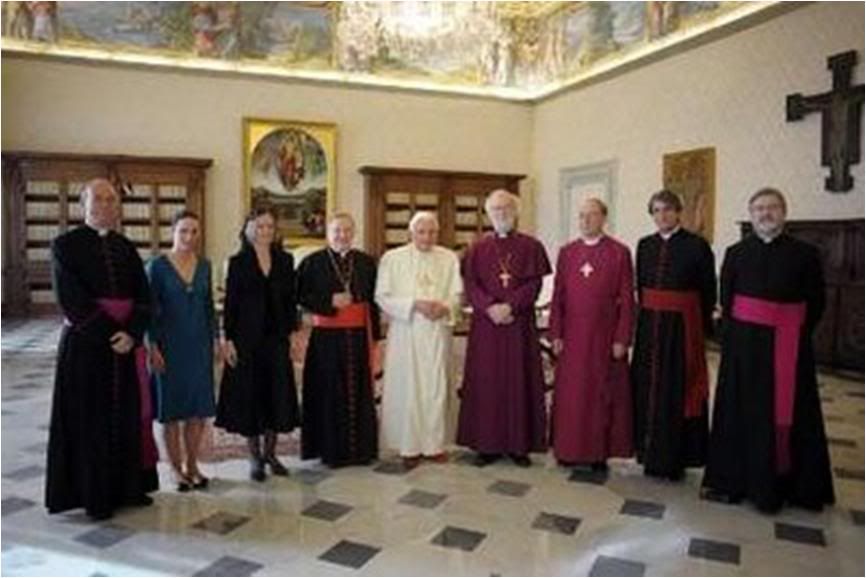 Pope and Anglican leader
Pope and Anglican leader
agree on closer relations
By VICTOR L. SIMPSON

VATICAN CITY, Nov. 21 (AP) – The archbishop of Canterbury held his first talks Saturday with Pope Benedict XVI since the Roman Catholic Church's unprecedented invitation to disaffected Anglicans, with the Vatican saying the two sides still want to press ahead for closer relations.
Archbishop Rowan Williams and Benedict met privately for 20 minutes in what the Vatican called "cordial discussions," as part of what has clearly been a difficult visit by the Anglican leader.
The Vatican said in a brief statement that the two leaders "turned to the challenges facing all Christian communities" and the need "to promote forms of collaboration and shared witness in facing these challenges."
Referring to the recent overture for traditional Anglicans upset over the ordination of women and gay bishops to become Catholics, it said the talks reiterated "the shared will to continue and to consolidate the ecumenical relationship between Catholics and Anglicans."
The Vatican said the Pope presented the archbishop with a gold bishop's cross as a gift.
There was no immediate comment from the Anglican side and the Vatican declined to elaborate.
Since coming to Rome on Thursday, Williams has sought to downplay the implications of the Vatican's unprecedented invitation.
[One would not think so, reading the British newspapers. The London Times said of the visit: "Williams in Rome" The fightback begins", which is ridiculous as 1) Williams really has nothing to fight back with; and 2) the full text of Williams's Willebrands address is available on line (the Vatican newspaper also carried it in full today in the Italian translation) - and it was not a 'fightback' message at all, even if it was understandably very defensive.
As for Williams's rhetorical question about a possible accommodation with the Catholic Church over female priests, that was all it was - rhetoric! Because he can't even get his own Communion to buy into the infamous and improbable two-track plan he proposed for the Anglicans last summer, in which dioceses, parishes and individuals could choose to take sides in the ideological divide over anti-tradition women and gay priests as well as same-sex 'marriage'.]
The Vatican says it was merely responding to the many Anglican requests to join the Catholic Church and has denied it was poaching converts in the Anglican pond.
But the move has already strained Catholic-Anglican relations and is sure to affect Williams's 77-million worldwide Anglican Communion, which was already on the verge of schism over homosexuality and women's ordination before the Vatican intervened.
In a speech at the Pontifical Gregorian University in Rome, Williams was gracious in referring to the Vatican's new policy, which he called the "elephant in the room." The policy was an "imaginative pastoral response" to requests by some Anglicans but broke no new doctrinal ground, Williams said.
He spent the bulk of his speech describing the progress that had been achieved so far in decades of Vatican-Anglican ecumenical talks and questioning whether the outstanding issues were really all that great.
Anglicans split from Rome in 1534 when English King Henry VIII was refused a marriage annulment. For decades, the two churches have held theological discussions on trying to reunite, part of the Vatican's broader, long-term ecumenical effort to unify all Christians.
But differences remain and the ecumenical talks were going nowhere as divisions mounted between liberals and traditionalists within the Anglican Communion itself.
The new policy allows Anglicans to convert to Catholicism but retain many of their Anglican liturgical traditions, including married priests. The Vatican will create the equivalent of new dioceses, so-called personal ordinariates, for these former Anglicans to be headed by a former Anglican priest or bishop.
Estimates on the number of possible converts has ranged from a few hundred to thousands.
Williams — the spiritual leader of the worldwide Anglican Communion — wasn't informed of the change until right before it was announced.
It remains to be seen how the new policy will affect Pope Benedict XVI's planned trip to Britain next year. Saturday's Vatican statement did not mention it [because neither side has officially announced it] .
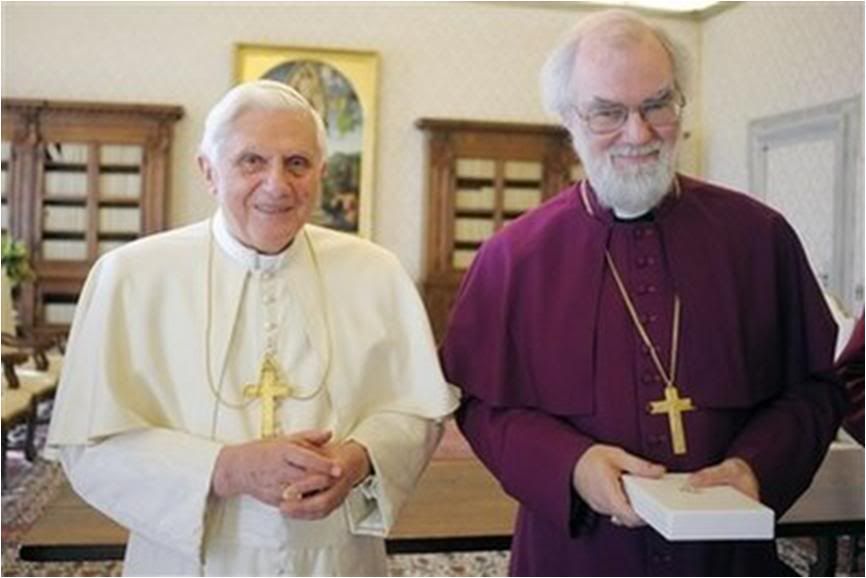 A pre-meeting article in the British daily Independent today has some surprising angles, even if the headline has nothing to do with the story!
A warm welcome from the Pope
A pre-meeting article in the British daily Independent today has some surprising angles, even if the headline has nothing to do with the story!
A warm welcome from the Pope
sows Anglican unease
By Simon Caldwell

Saturday, 21 November 2009
Pope Benedict XVI will today greet Rowan Williams, the Archbishop of Canterbury and leader of the worldwide Anglican Communion, for the first time since the Vatican announced the creation of a canonical structure to receive groups of Anglican converts en masse.
The pair will hold a private meeting at the Vatican at a delicate time for relations between the churches. Last month, Pope Benedict unveiled a special structure to allow traditionalist Anglican ministers, including married ones, and lay people to join the Catholic Church.
The decree, for the first time in history, allows the creation of "personal ordinariates" in which Anglo-Catholics can preserve their traditions but in communion with the Pope. Anglo-Catholic leaders have generally welcomed the move as an act of generosity.
But it has caused unease within parts of the Church of England because some clergy fear it could further undermine the worldwide Anglican Communion.
What Dr Williams understands more clearly than many in the Church of England is that, although he is being held accountable for many of the difficulties in his church, the creation of personal ordinariates are not a reflection on him.
He is not like an Anglican pope, a focus of unity who can hold together 80 million members by clarifying and enforcing doctrine. The ordinariates do not even reflect on the state of the Church of England, troubled as it is. The Vatican has more fertile pastures in mind.
Principally, these can be found in Australia and the United States, both countries in which one in four of the population is Catholic (compared to one in 10 in England) and where the majority of requests for group receptions from Anglicanism and into the Catholic Church have originated.
"This is not about the Church of England," one Vatican insider said. "The UK is just caught in a slipstream. The Vatican respects Rowan but it does no much care what the Church of England bishops – or indeed the Catholic bishops in England and Wales – think. The focus is all on America which Rome thinks is the most important national church, more important than Italy now."
The US Church has "healthy congregations of young people", for instance. It is robust, rich and increasingly influential. And the leaders of this church of some 60 million Catholics have been pushing for changes in the way Anglican converts are received.
This was highlighted by the embarrassment caused to the US Catholic bishops when the Episcopal bishop in New Mexico, Jeffrey Steenson, resigned over the election of Gene Robinson as the first openly gay bishop, as well as the blessing of same-sex unions.
Bishop Steenson wanted to become a Catholic priest but was made to go back to university in Rome and be re-ordained. Instead of being welcomed as a hero, he was humiliated. [I need to check this out.] This led for an appraisal of the way things were done.
As for Rowan Williams, the affection for him within the Vatican is genuine. He will be welcomed as a friend. He can relax. One source said: "Rome has decided to lay out a red carpet that is long and deep for Rowan because they like and respect him personally.
"They know he needs symbolic support. They can see now that he's been badly damaged by all this among Anglicans. He's playing a long game, with an eye to Anglican/RC relations, perhaps even after he and Benedict have gone, but he's being seen as too deferential ... but in the end Rome doesn't much care about England – Anglican or Catholic – they have a much wider perspective."
This insight is certainly shared by Cardinal Cormac Murphy-O'Connor, the emeritus Archbishop of Westminster. In a speech last month, he revealed that group reception was first discussed with Cardinal Ratzinger in 1993 and 1994 by the English Catholic leadership, after a request from the Anglo-Catholic group, Forward in Faith. "It was finally decided that it would not be appropriate to take this initiative," the cardinal said.
"The personal ordinariates offered by the Holy Father can be seen not in any way unecumenical but rather as a generous response to people who have been knocking at the door for a long time."
[Modificato da TERESA BENEDETTA 20/11/2010 00:08] |
| |
 21/11/2009 14:25 21/11/2009 14:25 |
|
| | | OFFLINE | | Post: 18.916
Post: 1.564 | Registrato il: 28/08/2005
Registrato il: 20/01/2009 | Administratore | Utente Veteran | |
|
 Reserved for translations of a couple of excellent preparatory stories on the meeting with artists from the Italian media today.
Reserved for translations of a couple of excellent preparatory stories on the meeting with artists from the Italian media today.
[Modificato da TERESA BENEDETTA 04/12/2009 00:49] |
| |
 21/11/2009 14:38 21/11/2009 14:38 |
|
| | | OFFLINE | | Post: 18.917
Post: 1.565 | Registrato il: 28/08/2005
Registrato il: 20/01/2009 | Administratore | Utente Veteran | |
|
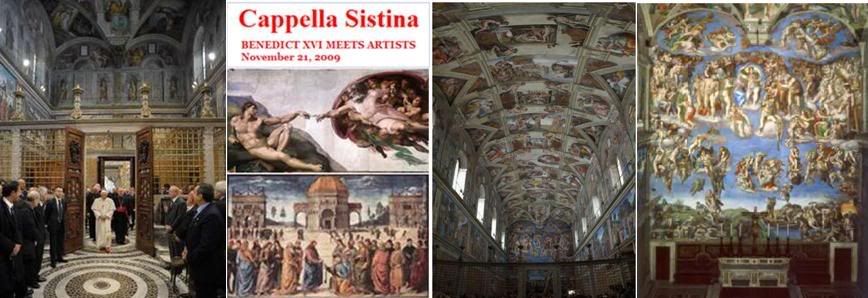 Benedict XVI to artists:
Benedict XVI to artists:
'Art means revealing God
in everything that exists'
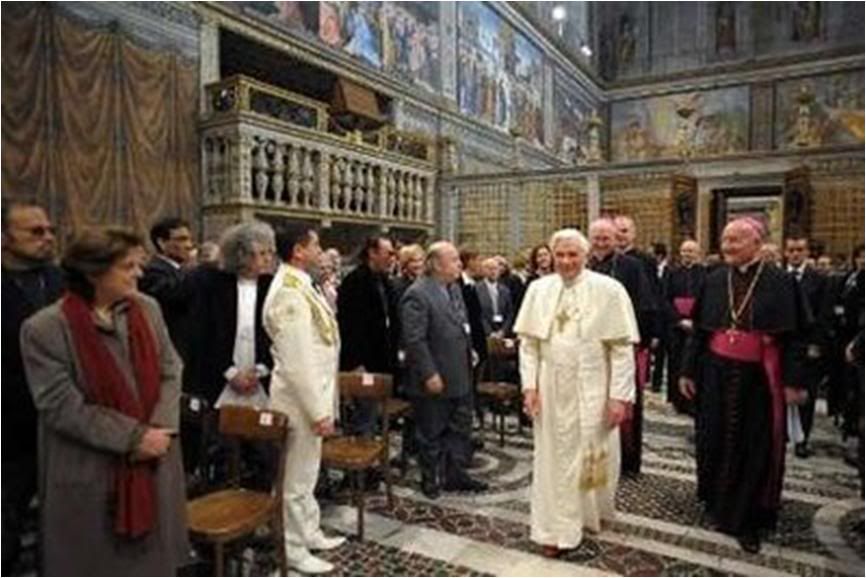

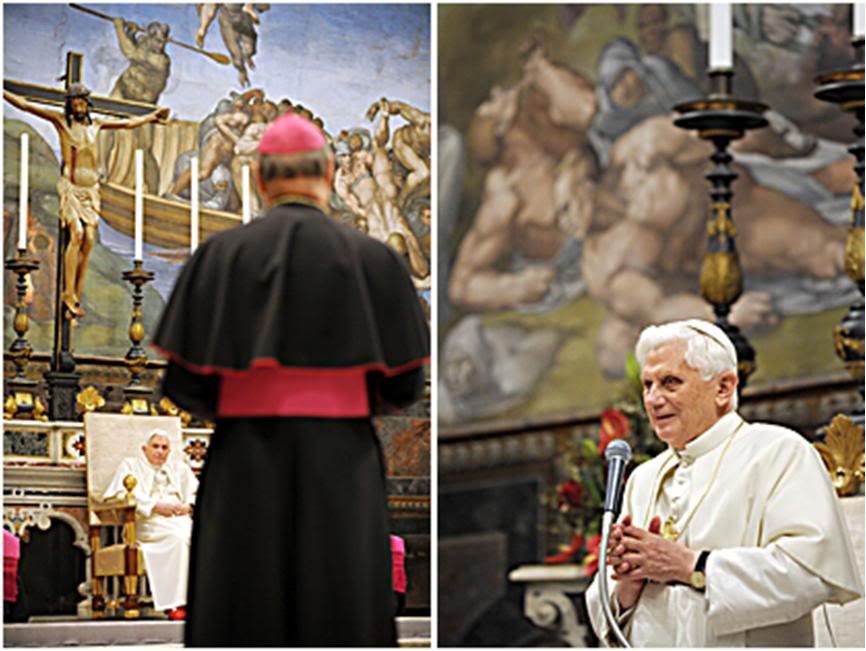 Here is the Vatican's English translation of the Holy Father's address today to some 250 artists from Italy and other countries who were invited to a meeting at the Sistine Chapel. The address was delivered in Italian, with brief greetings at the end in French, English, German and Spanish.
Here is the Vatican's English translation of the Holy Father's address today to some 250 artists from Italy and other countries who were invited to a meeting at the Sistine Chapel. The address was delivered in Italian, with brief greetings at the end in French, English, German and Spanish.
Dear Cardinals,
Brother Bishops and Priests,
Distinguished Artists,
Ladies and Gentlemen,
With great joy I welcome you to this solemn place, so rich in art and in history. I cordially greet each and every one of you and I thank you for accepting my invitation.
At this gathering I wish to express and renew the Church’s friendship with the world of art, a friendship that has been strengthened over time; indeed Christianity from its earliest days has recognized the value of the arts and has made wise use of their varied language to express her unvarying message of salvation.
This friendship must be continually promoted and supported so that it may be authentic and fruitful, adapted to different historical periods and attentive to social and cultural variations. Indeed, this is the reason for our meeting here today.
I am deeply grateful to Archbishop Gianfranco Ravasi, President of the Pontifical Council for Culture and of the Pontifical Commission for the Cultural Patrimony of the Church, and likewise to his officials, for promoting and organizing this meeting, and I thank him for the words he has just addressed to me.
I greet the Cardinals, the Bishops, the priests and the various distinguished personalities present. I also thank the Sistine Chapel Choir for their contribution to this gathering.
Today’s event is focused on you, dear and illustrious artists, from different countries, cultures and religions, some of you perhaps remote from the practice of religion, but interested nevertheless in maintaining communication with the Catholic Church, in not reducing the horizons of existence to mere material realities, to a reductive and trivializing vision.
You represent the varied world of the arts and so, through you, I would like to convey to all artists my invitation to friendship, dialogue and cooperation.
Some significant anniversaries occur around this time. It is ten years since the Letter to Artists by my venerable Predecessor, the Servant of God Pope John Paul II. For the first time, on the eve of the Great Jubilee of the Year 2000, the Pope, who was an artist himself, wrote a Letter to Artists, combining the solemnity of a pontifical document with the friendly tone of a conversation among all who, as we read in the initial salutation, "are passionately dedicated to the search for new ‘epiphanies’ of beauty".
Twenty-five years ago the same Pope proclaimed Blessed Fra Angelico the patron of artists, presenting him as a model of perfect harmony between faith and art.
I also recall how on 7 May 1964, forty-five years ago, in this very place, an historic event took place, at the express wish of Pope Paul VI, to confirm the friendship between the Church and the arts. The words that he spoke on that occasion resound once more today under the vault of the Sistine Chapel and touch our hearts and our minds.
"We need you," he said. "We need your collaboration in order to carry out our ministry, which consists, as you know, in preaching and rendering accessible and comprehensible to the minds and hearts of our people the things of the spirit, the invisible, the ineffable, the things of God himself. And in this activity … you are masters. It is your task, your mission, and your art consists in grasping treasures from the heavenly realm of the spirit and clothing them in words, colours, forms – making them accessible."
So great was Paul VI’s esteem for artists that he was moved to use daring expressions. "And if we were deprived of your assistance," he added, "our ministry would become faltering and uncertain, and a special effort would be needed, one might say, to make it artistic, even prophetic. In order to scale the heights of lyrical expression of intuitive beauty, priesthood would have to coincide with art."
On that occasion Paul VI made a commitment to "re-establish the friendship between the Church and artists", and he invited artists to make a similar, shared commitment, analyzing seriously and objectively the factors that disturbed this relationship, and assuming individual responsibility, courageously and passionately, for a newer and deeper journey in mutual acquaintance and dialogue in order to arrive at an authentic "renaissance" of art in the context of a new humanism.
That historic encounter, as I mentioned, took place here in this sanctuary of faith and human creativity. So it is not by chance that we come together in this place, esteemed for its architecture and its symbolism, and above all for the frescoes that make it unique, from the masterpieces of Perugino and Botticelli, Ghirlandaio and Cosimo Rosselli, Luca Signorelli and others, to the Genesis scenes and the Last Judgement of Michelangelo Buonarroti, who has given us here one of the most extraordinary creations in the entire history of art.
The universal language of music has often been heard here, thanks to the genius of great musicians who have placed their art at the service of the liturgy, assisting the spirit in its ascent towards God.
At the same time, the Sistine Chapel is remarkably vibrant with history, since it is the solemn and austere setting of events that mark the history of the Church and of mankind.
Here as you know, the College of Cardinals elects the Pope; here it was that I myself, with trepidation but also with absolute trust in the Lord, experienced the privileged moment of my election as Successor of the Apostle Peter.
Dear friends, let us allow these frescoes to speak to us today, drawing us towards the ultimate goal of human history. The Last Judgement, which you see behind me, reminds us that human history is movement and ascent, a continuing tension towards fullness, towards human happiness, towards a horizon that always transcends the present moment even as the two coincide.
Yet the dramatic scene portrayed in this fresco also places before our eyes the risk of man’s definitive fall, a risk that threatens to engulf him whenever he allows himself to be led astray by the forces of evil. So the fresco issues a strong prophetic cry against evil, against every form of injustice.
For believers, though, the Risen Christ is the Way, the Truth and the Life. For his faithful followers, he is the Door through which we are brought to that "face-to-face" vision of God from which limitless, full and definitive happiness flows.
Thus Michelangelo presents to our gaze the Alpha and the Omega, the Beginning and the End of history, and he invites us to walk the path of life with joy, courage and hope. The dramatic beauty of Michelangelo’s painting, its colours and forms, becomes a proclamation of hope, an invitation to raise our gaze to the ultimate horizon.
The profound bond between beauty and hope was the essential content of the evocative Message that Paul VI addressed to artists at the conclusion of the Second Vatican Ecumenical Council on 8 December 1965:
"To all of you," he proclaimed solemnly, "the Church of the Council declares through our lips: if you are friends of true art, you are our friends!"
And he added: "This world in which we live needs beauty in order not to sink into despair. Beauty, like truth, brings joy to the human heart, and is that precious fruit which resists the erosion of time, which unites generations and enables them to be one in admiration. And all this through the work of your hands . . . Remember that you are the custodians of beauty in the world."
Unfortunately, the present time is marked, not only by negative elements in the social and economic sphere, but also by a weakening of hope, by a certain lack of confidence in human relationships, which gives rise to increasing signs of resignation, aggression and despair.
The world in which we live runs the risk of being altered beyond recognition because of unwise human actions which, instead of cultivating its beauty, unscrupulously exploit its resources for the advantage of a few and not infrequently disfigure the marvels of nature.
What is capable of restoring enthusiasm and confidence, what can encourage the human spirit to rediscover its path, to raise its eyes to the horizon, to dream of a life worthy of its vocation – if not beauty?
Dear friends, as artists you know well that the experience of beauty, beauty that is authentic, not merely transient or artificial, is by no means a supplementary or secondary factor in our search for meaning and happiness; the experience of beauty does not remove us from reality, on the contrary, it leads to a direct encounter with the daily reality of our lives, liberating it from darkness, transfiguring it, making it radiant and beautiful.
Indeed, an essential function of genuine beauty, as emphasized by Plato, is that it gives man a healthy "shock", it draws him out of himself, wrenches him away from resignation and from being content with the humdrum – it even makes him suffer, piercing him like a dart, but in so doing it "reawakens" him, opening afresh the eyes of his heart and mind, giving him wings, carrying him aloft.
Dostoevsky’s words that I am about to quote are bold and paradoxical, but they invite reflection. He says this: "Man can live without science, he can live without bread, but without beauty he could no longer live, because there would no longer be anything to do to the world. The whole secret is here, the whole of history is here."
The painter Georges Braque echoes this sentiment: "Art is meant to disturb, science reassures."
Beauty pulls us up short, but in so doing it reminds us of our final destiny, it sets us back on our path, fills us with new hope, gives us the courage to live to the full the unique gift of life. The quest for beauty that I am describing here is clearly not about escaping into the irrational or into mere aestheticism.
Too often, though, the beauty that is thrust upon us is illusory and deceitful, superficial and blinding, leaving the onlooker dazed; instead of bringing him out of himself and opening him up to horizons of true freedom as it draws him aloft, it imprisons him within himself and further enslaves him, depriving him of hope and joy.
It is a seductive but hypocritical beauty that rekindles desire, the will to power, to possess, and to dominate others, it is a beauty which soon turns into its opposite, taking on the guise of indecency, transgression or gratuitous provocation.
Authentic beauty, however, unlocks the yearning of the human heart, the profound desire to know, to love, to go towards the Other, to reach for the Beyond.
If we acknowledge that beauty touches us intimately, that it wounds us, that it opens our eyes, then we rediscover the joy of seeing, of being able to grasp the profound meaning of our existence, the Mystery of which we are part; from this Mystery we can draw fullness, happiness, the passion to engage with it every day.
In this regard, Pope John Paul II, in his Letter to Artists, quotes the following verse from a Polish poet, Cyprian Norwid: "Beauty is to enthuse us for work, and work is to raise us up" (no. 3).
And later he adds: "In so far as it seeks the beautiful, fruit of an imagination which rises above the everyday, art is by its nature a kind of appeal to the mystery. Even when they explore the darkest depths of the soul or the most unsettling aspects of evil, the artist gives voice in a way to the universal desire for redemption" (no. 10). And in conclusion he states: "Beauty is a key to the mystery and a call to transcendence" (no. 16).
These ideas impel us to take a further step in our reflection. Beauty, whether that of the natural universe or that expressed in art, precisely because it opens up and broadens the horizons of human awareness, pointing us beyond ourselves, bringing us face to face with the abyss of Infinity, can become a path towards the transcendent, towards the ultimate Mystery, towards God.
Art, in all its forms, at the point where it encounters the great questions of our existence, the fundamental themes that give life its meaning, can take on a religious quality, thereby turning into a path of profound inner reflection and spirituality.
This close proximity, this harmony between the journey of faith and the artist’s path is attested by countless artworks that are based upon the personalities, the stories, the symbols of that immense deposit of "figures" – in the broad sense – namely the Bible, the Sacred Scriptures.
The great biblical narratives, themes, images and parables have inspired innumerable masterpieces in every sector of the arts, just as they have spoken to the hearts of believers in every generation through the works of craftsmanship and folk art, that are no less eloquent and evocative.
In this regard, one may speak of a via pulchritudinis, a path of beauty which is at the same time an artistic and aesthetic journey, a journey of faith, of theological enquiry.
The theologian Hans Urs von Balthasar begins his great work entitled The Glory of the Lord – a Theological Aesthetics with these telling observations: "Beauty is the word with which we shall begin. Beauty is the last word that the thinking intellect dares to speak, because it simply forms a halo, an untouchable crown around the double constellation of the true and the good and their inseparable relation to one another."
He then adds: "Beauty is the disinterested one, without which the ancient world refused to understand itself, a word which both imperceptibly and yet unmistakably has bid farewell to our new world, a world of interests, leaving it to its own avarice and sadness. It is no longer loved or fostered even by religion."
And he concludes: "We can be sure that whoever sneers at her name as if she were the ornament of a bourgeois past – whether he admits it or not – can no longer pray and soon will no longer be able to love."
The way of beauty leads us, then, to grasp the Whole in the fragment, the Infinite in the finite, God in the history of humanity.
Simone Weil wrote in this regard: "In all that awakens within us the pure and authentic sentiment of beauty, there, truly, is the presence of God. There is a kind of incarnation of God in the world, of which beauty is the sign. Beauty is the experimental proof that incarnation is possible. For this reason all art of the first order is, by its nature, religious."
Hermann Hesse makes the point even more graphically: "Art means: revealing God in everything that exists."
Echoing the words of Pope Paul VI, the Servant of God Pope John Paul II restated the Church’s desire to renew dialogue and cooperation with artists: "In order to communicate the message entrusted to her by Christ, the Church needs art" (no. 12); but he immediately went on to ask: "Does art need the Church?" – thereby inviting artists to rediscover a source of fresh and well-founded inspiration in religious experience, in Christian revelation and in the "great codex" that is the Bible.
Dear artists, as I draw to a conclusion, I too would like to make a cordial, friendly and impassioned appeal to you, as did my Predecessor.
You are the custodians of beauty: thanks to your talent, you have the opportunity to speak to the heart of humanity, to touch individual and collective sensibilities, to call forth dreams and hopes, to broaden the horizons of knowledge and of human engagement.
Be grateful, then, for the gifts you have received and be fully conscious of your great responsibility to communicate beauty, to communicate in and through beauty! Through your art, you yourselves are to be heralds and witnesses of hope for humanity!
And do not be afraid to approach the first and last source of beauty, to enter into dialogue with believers, with those who, like yourselves, consider that they are pilgrims in this world and in history towards infinite Beauty!
Faith takes nothing away from your genius or your art: on the contrary, it exalts them and nourishes them, it encourages them to cross the threshold and to contemplate with fascination and emotion the ultimate and definitive goal, the sun that does not set, the sun that illumines this present moment and makes it beautiful.
Saint Augustine, who fell in love with beauty and sang its praises, wrote these words as he reflected on man’s ultimate destiny, commenting almost ante litteram on the Judgement scene before your eyes today:
"Therefore we are to see a certain vision, my brethren, that no eye has seen, nor ear heard, nor the heart of man conceived: a vision surpassing all earthly beauty, whether it be that of gold and silver, woods and fields, sea and sky, sun and moon, or stars and angels. The reason is this: it is the source of all other beauty" (In 1 Ioannis, 4:5).
My wish for all of you, dear artists, is that you may carry this vision in your eyes, in your hands, and in your heart, that it may bring you joy and continue to inspire your fine works. From my heart I bless you and, like Paul VI, I greet you with a single word: arrivederci!
Je suis heureux de saluer tous les artistes présents. Chers amis, je vous encourage à découvrir et à exprimer toujours mieux, à travers la beauté de vos œuvres, le mystère de Dieu et le mystère de l’homme. Que Dieu vous bénisse!
Dear friends, thank you for your presence here today. Let the beauty that you express by your God-given talents always direct the hearts of others to glorify the Creator, the source of all that is good. God’s blessings upon you all!
Sehr herzlich grü$e ich euch, liebe Freunde. Mit eurem künstlerischen Talent macht ihr gleichsam das Schöpferwirken Gottes sichtbar. Der Herr, der uns im Schönen nah sein will, erfülle euch mit seinem Geist der Liebe. Gott segne euch alle.
Saludo cordialmente a los artistas que participan en este encuentro. Queridos amigos, os animo a fomentar el sentido y las manifestaciones de la hermosura en la creación. Que Dios os bendiga. Muchas gracias.
 Pope tells artists
Pope tells artists
beauty can be a path to God
By Daniel Flynn

VATICAN CITY, Nov. 21 (Reuters) – Pope Benedict met artists from around the world in the Sistine Chapel on Saturday and urged them to inject spirituality into their work, saying contemporary beauty was often "illusory and deceitful."
The Pope told the gathering of hundreds of painters, sculptors, architects, poets and directors, held beneath the vaulted ceiling of the chapel painted by Michelangelo, that he wanted to "renew the Church's friendship with the world of art."
"Beauty ... can become a path toward the transcendent, toward the ultimate Mystery, toward God," Benedict said.
The Vatican said it invited some 500 artists to the event, regardless of religious, political or stylistic allegiances.
More than 250 accepted, mostly from Italy, including singer Andrea Bocelli and award-winning film composer Ennio Morricone.
Amongst the other guests were Iraqi-born British architect Zaha Hadid, whose Maxxi modern art museum has just opened in Rome, and F. Murray Abraham, the American actor who won an Oscar for his role as Salieri in the Mozart film, Amadeus, in 1985.
The Pope told them that in a world lacking in hope, with increasing signs of aggression and despair, there was an ever greater need for a return to spirituality in art.
"Too often ... the beauty thrust upon us is illusory and deceitful ... it imprisons man within himself and further enslaves him, depriving him of hope and joy," he said.
Against the backdrop of Michelangelo's vast fresco of the Last Judgment, which adorns the chapel's altar wall, Benedict lamented that the once-close cooperation between the Church and the artistic community had weakened.
"Faith takes nothing away from your genius or art," he said. "On the contrary, it exalts them and nourishes them."
Saturday's event marked both the 10th anniversary of Pope John Paul II's 'Letter to Artists' in 1999 in which he spoke of the Church's "need for art," and the 45th anniversary of Pope Paul VI's original meeting with artists in 1964.
After a number of spats between the Vatican and artists in recent years, including a controversy surrounding writer Dan Brown's Da Vinci Code, the latest overture to the artistic world is being driven by the Vatican's new culture commissar, Archbishop Gianfranco Ravasi. [And how does the controversy over Dan Brown's work come to be seen as a Vatican 'spat with artists'? The Reuters reporter must be the first journalist ever to consider a producer of ill-researched malicious potboilers - even if he happens to be the world's current bestselling pulp fiction-seller - an 'artist'!]
In a sign of efforts at reconciliation, the Vatican has said it will participate in the 2011 Venice Biennale, one of the world's major art festivals held every two years.

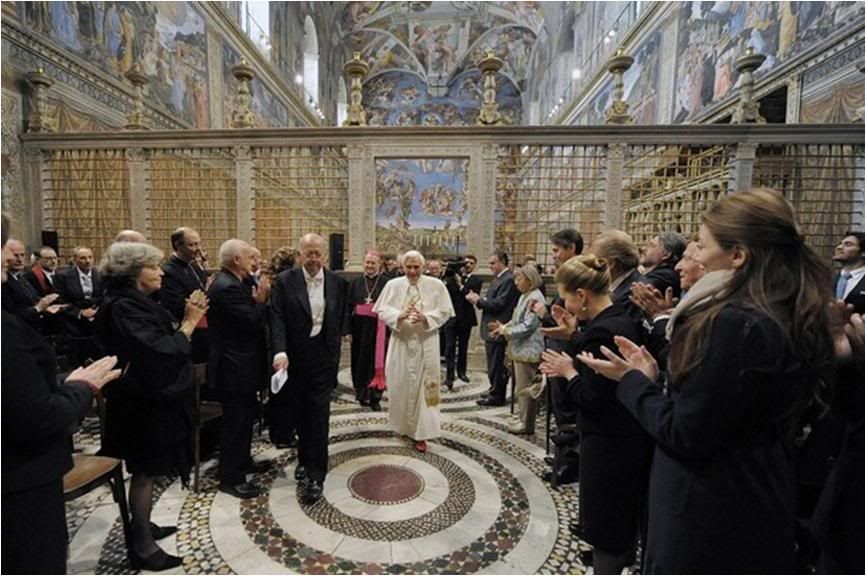
[Modificato da TERESA BENEDETTA 22/11/2009 22:42] |
| |
 22/11/2009 14:27 22/11/2009 14:27 |
|
| | | OFFLINE | | Post: 18.921
Post: 1.569 | Registrato il: 28/08/2005
Registrato il: 20/01/2009 | Administratore | Utente Veteran | |
|
 Other than the Holy Father's address, OR today has an editorial and three other items about the meeting with artists yesterday at the Sistine Chapel. First, the editorial:
Other than the Holy Father's address, OR today has an editorial and three other items about the meeting with artists yesterday at the Sistine Chapel. First, the editorial:
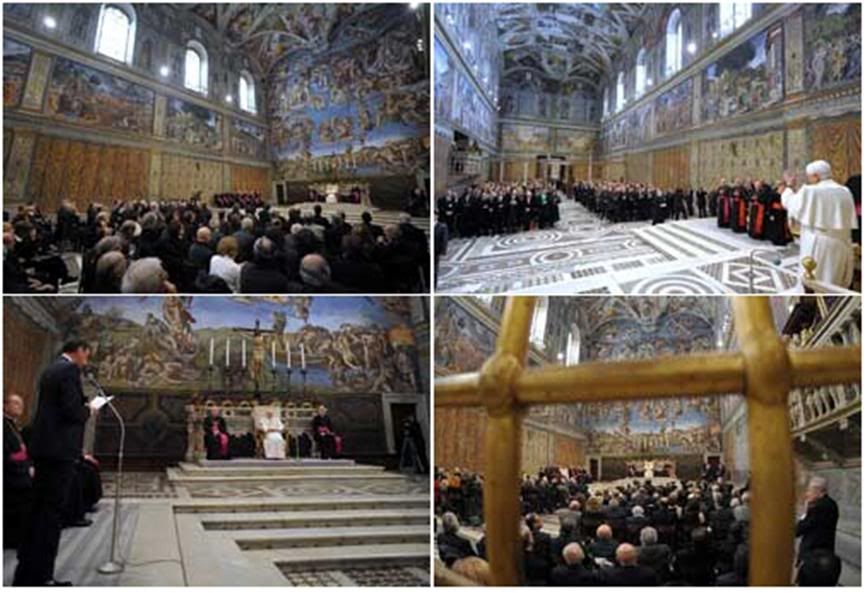 A new alliance
A new alliance
Editorial by Giovanni Maria Vian
Translated from
the 11/22/09 issue of

The closeness between Church and art is old. Almost as old as the Christian tradition to which the different artistic expressions have been historically linked as to no other religion in the world.
Nonetheless, this close linkage, which matured in late antiquity, was weakened during the 19th century, finally changing into the remoteness of the 20th century, which is worse today at a time when disinterested beauty "has taken leave, on tiptoes, of the modern world of interests", as Hans Urs von Balthasar noted in the citation made by Benedict XVI at the Sistine Chapel Saturday.
In the very place where Paul VI proposed to artists in 1964 to relaunch an alliance that had left lasting fruits in the course of nearly twenty centuries, his present successor invited men and women in the arts - of various nations, cultures and religions, "perhaps even far from religious experiences, but desirous of maintaining communications alive with the Catholic Church" - to friendship, dialog and collaboration.
Renewing the invitation in a place fraught with symbols as the Sistine Chapel is, where music has often resounded and continues to resound in the service of liturgy, and therefore of God, 'the source of every beauty' as St. Augustine said.
And following his predecessor John Paul II - 'an artist himself', who addressed a solemn papal document to artists in 1999 - and with the same openness shown by Paul VI, without hiding actual difficulties, Benedict XVI re-proposed the alliance there had been in the past: "We need you", because "if you are friends of true art, you are our friends". These words are also contained in the message of the Second Vatican Council to artists.
Because beauty, like truth, brings joy to the heart of man. Which is why it is worthwhile to have an alliance between the custodians of beauty and those who, in their humble daily work, are called on to testify and serve the truth.
Then, here is a translation of Mons. Ravasi's opening remarks:
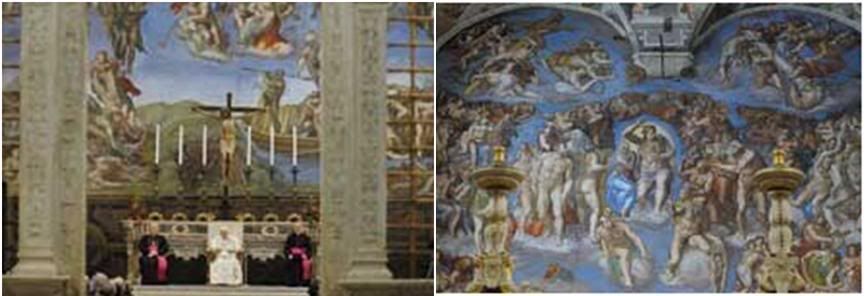
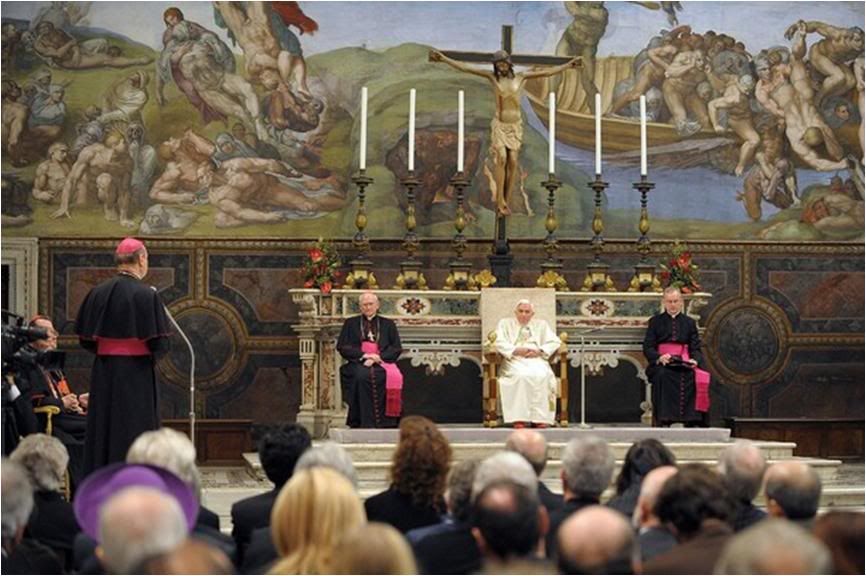 After clearing up the rubble of incomprehensions,
After clearing up the rubble of incomprehensions,
the 'way of beauty' remains open
by Mons. Gianfranco Ravasi
President, Pontifical Council for Culture
Translated from
the 11/22/09 issue of

Holiness,
It is not easy to give voice to this crowd of artists coming from around the world, in representation of many of their colleagues.
Indeed, a profound emotion runs through everyone in the face of this grand and glorious Michelangelo setting, the supreme symbol of the encounter of faith and art, and in front of the Successor of Peter, who embodies the centuries-long history of the Church.
Forty-five years ago, on May 7, 1964, in this same extraordinary setting, Pope Paul VI, in a passionate discourse addressed to artists, reminded them that the ultimate challenge of aesthetic creation is to "seize from heaven its spirit and its treasures and clothe them in words, in colors, in forms" to make them accessible.
In the limited way of word, form, image, sound, the artist seeks, in fact, to let the infinite and the eternal burst forth.
As one of them, the Catalan artist Joan Miro, said, "Art does not represent the visible but makes visible the Invisible. It faces the abysses of being and existence, it goes beyond the limits of immediate evidence to penetrate into the regions of the absolute and the transcendent."
Ten years ago, Holiness, your venerated predecessor John Paul II, on Easter Day 1999, wrote his Letter to Artists "to confirm his esteem for them but also to contribute in re-starting a more fruitful cooperation between art and the Church", in order to renew "that fertile conversation which was never interrupted in two thousand years".
Behind us in fact is that immense and wondrous legacy which made Goethe say, "The mother tongue of Europe is Christianity".
Marc Chagall was convinced, as you recalled, Holiness, last Wednesday - that for centuries, "painters dipped their brushes into the multicolored alphabet of the Bible".
Already in the eighth century, that singer of sacred images, St. John Damascene, did not hesitate to suggest: "If a pagan comes and says to you, 'Show me your faith!', bring him to a church and show him the decorations with which it is adorned, and explain to him the series of sacred paintings".
This very close link, starting in the last century, has loosened a lot. On the one hand, spiritual reflection has not always followed the way of the 'theological aesthetic', and in the ecclesial field, the recourse has often been to a rehash of styles and genres from preceding eras; or not uncommonly, we have become accustomed to the ugliness which afflicts the new cities.
On the other hand, art has followed the ways of the secular city, relegating to the archives the religious themes, symbols, narratives and figures of that cultural code that the Bible had been for centuries. It has often dedicated itself to the ephemeral, and to stylistic exercises that have become ever more provocative and self-referential, and subject to the fashions and logic of the market.
And yet everyone desires to re-weave that 'fertile conversation'. The artists now await, Holiness, that your words will strike the first chord of this new dialog, in which, as you have already said, "aesthetics and ethics, beauty, truth and goodness" may intersect.
After clearing up the rubble of incomprehensions and distances, the via pulchritudinis is still open to all, to the believer and to the artist. The goal is that which the writer Hermann Hesse described in his essay 'Klein und Wagner': "Art means to show God in everything", that is, the Eternal and the Infinite.
It is what John Paul II wished for in his Letter: "Let art contribute to the affirmation of authentic beauty which, almost like a reverberation of the spirit of God, transfigures matter, opening souls to a sense of the eternal".
Now, Holiness, as we thank you for the gift that you wish, in your name, to be given to each artist present at the end of this meeting, we all look to you to illuminate us on this path of beauty and light, with words that we shall listen to with intense sympathy and lively participation.
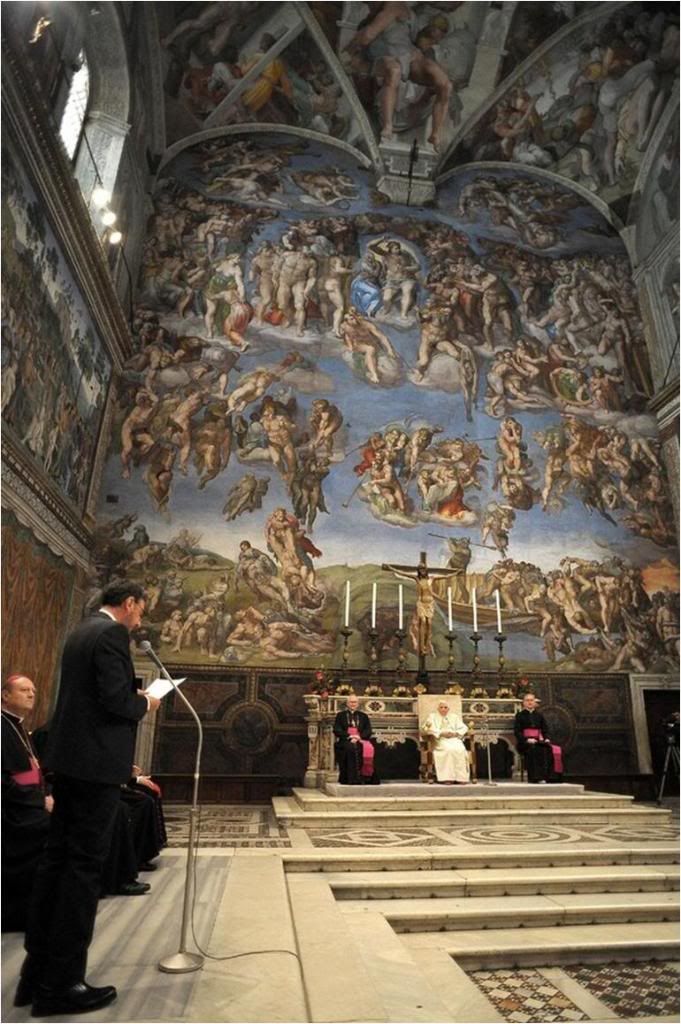 Actor Castellitto reads portions of John Paul II's Letter to Artists.
An 'Arrivederci' to mark
Actor Castellitto reads portions of John Paul II's Letter to Artists.
An 'Arrivederci' to mark
dialog between art and faith
Translated from
the 11/22/09 issue of

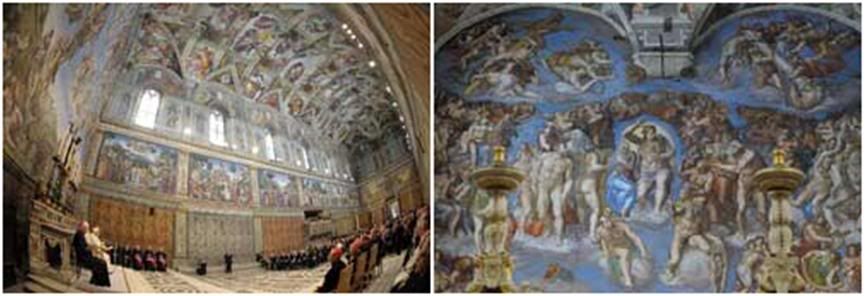
Long applause at the end of Benedict XVI's address was the most authentic expression of the experience lived by many artists who met the Pope on Saturday morning at the Sistine Chapel.
At least 250 painters, sculptors, architects, singers, composers, film and theater directors, actors, musicians and dancers gathered together in front of Michelangelo's Last Judgment to listen to the Pope.
Thus was renewed the friendly meeting first held between representatives of teh arts and the Successor of Peter, which took place on May 7, 1964 with Paul VI.
The words of that Servant of God, reiterated by Benedict XVI, echoed once more as an invitation to dialog: "We need you. Our ministry needs your collaboration".
The meeting was along the secular tradition of friendship between the Church, culture and art. A composition of Palestrina, 'Domine quando veneris', executed by the Sistine Chapel Choir, preceded the reading by actor-director Sergio Castellitto of portions from the letter to Artists written by John Paul II in April 1999.
The opening remarks by Archbishop Gianfranco Ravasi, president of the Pontifical Council for Culture, also echoed Papa Wojtyla's letter and Paul Vi's 1964 homily at an Ascension Day Mass for Artists.
The Pope's address was followed by his Apostolic Blessing, and another Palestrina composition, Veni dilecte, ended the encounter.
After the Pope left, Mons. Ravasi personally presented each of the artists, in the name of the Pope, with a medal that was specially minted for the occasion.
The guests were mostly Italians, with about 30-40 foreign representatives.
Among those present were from the Roman Curia were Cardinals Giovanni Lajolo, Paul Poupard and Francesco Marchisano; Archbishops Fernando Filoni and Dominique Mamberti, deputy secretaries of State; Mons. Mauro Piacenza, secretary of the Congregation for the Clergy; Mons. Claudio Maria Celli, president of the Pontifical Council for Social Communications; Fr. Bernard Ardura, secretary of the Pontifical Council for Culture' Abbot Michael John Zielinski, vice president of the Pontifical Council for the Cultural Assets of the Church; Antonio Paolucci, director of the Vatican Museums, and Franciso Buranelli, his predecessor.
Mons. Ravasi also had concluding remarks for the participants. He said that the Pope's final salutation, 'Arrivederci!', echoing Paul VI, was "a commitment for you and for me".
"We shall see," he said, "if we can have another meeting, perhaps with the Pope once more."
In any case, he said, the Pope's 'Arrivederci' must be the beginning of a new dialog based on the brotherhood of faith and art "that exists not because art must provide an apologetics of the faith but because art by its nature tends to burst through petty and limited schemes in order to represent the eternal and the infinite".
"That is why," he added, "from this day onward, we must reinforce this brotherhood between us who seek the transcendent and call it God, and you who seek the transcendent in other ways. Together we can do something".
He ended by announcing informally the possible participation of the Holy See with a pavilion at the next Venice Biennial art exhibition.
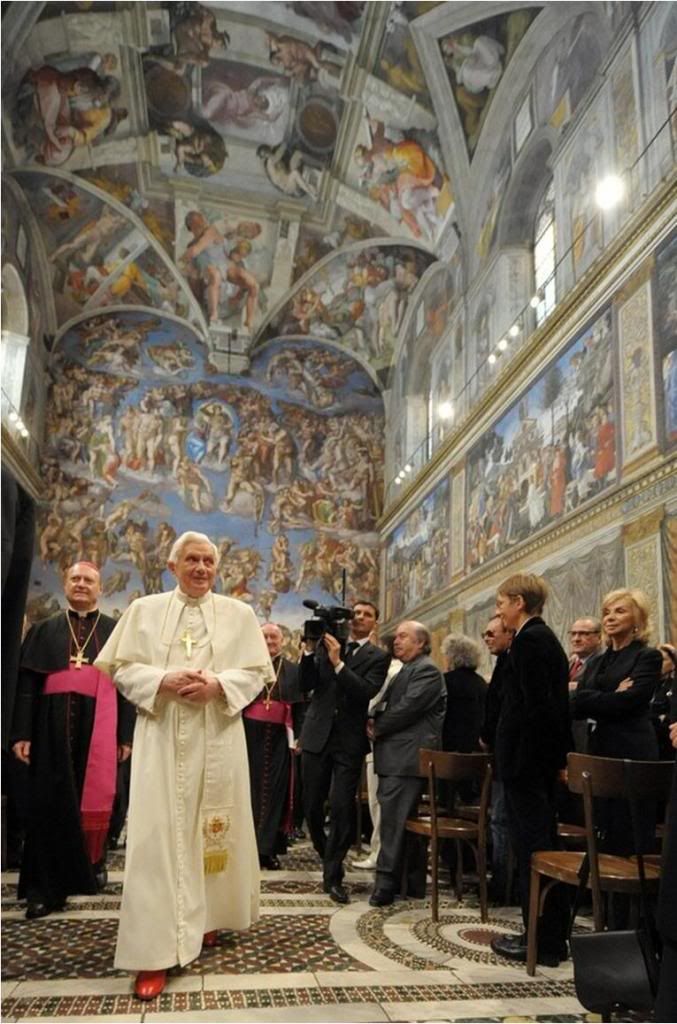
[Modificato da TERESA BENEDETTA 22/11/2009 21:28] |
| |
 22/11/2009 17:02 22/11/2009 17:02 |
|
| | | OFFLINE | | Post: 18.922
Post: 1.570 | Registrato il: 28/08/2005
Registrato il: 20/01/2009 | Administratore | Utente Veteran | |
|
 Sunday, November 22
Sunday, November 22
 FEAST OF CHRIST THE KING
FEAST OF CHRIST THE KING
Celebrated on the last Sunday of the liturgical year
Jesus is not often portrayed as a king, literally. The oldest known portrait of Christ is the 6th-century Pantocrator (leftmost photo) at the Monastery of St. Catherine in Sinai. Christ the King is often depicted as the Pantocrator, especially in Orthodox imagery. Christ at the Last Judgment (detail from Michelangelo's fresco) is the other usual 'kingly' portrayal of Christ. 'King of the Jews' images come with Crucifixion portrayals.
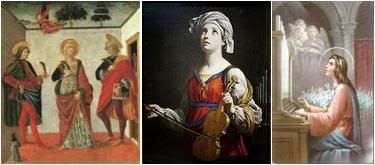 Left illustration shows Cecilia with Valerian and Tyburius;
Left illustration shows Cecilia with Valerian and Tyburius;
center is Guido Reni's portrait of the saint.
ST. CECILIA (Rome, 3rd century)
Virgin and Martyr, Patron of Music
For a saint who is so universally popular, little is known about this young Roman noblewoman.
The Golden Legend about her says she was married young to Valerian, whom she convinced
on their wedding night not only that they should be chaste but also to convert to Christianity.
He and his brother Tyburius converted, devoting themselves to burying Christian martyrs
and giving their goods to needy Christians. Eventually they were beheaded for refusing to
denounce the faith but not before converting Maximus, the guard assigned to them. The Roman
provost had him beheaded for this, and then sent for Cecilia, who refused to worship Jupiter
as ordered. He ordered her steamed to death in her bathroom, but when she was unharmed,
he had her beheaded. She survived the mandatory three sword strikes but lived three more
days, during which she gave away all she had, and converted more people to Christ.
Her musical fame rests on a passing notice in her legend that she praised God, singing
to him, as she lay dying. Her incorrupt body was found long after her death. Devotion to her
started in the 6th century.
OR today.
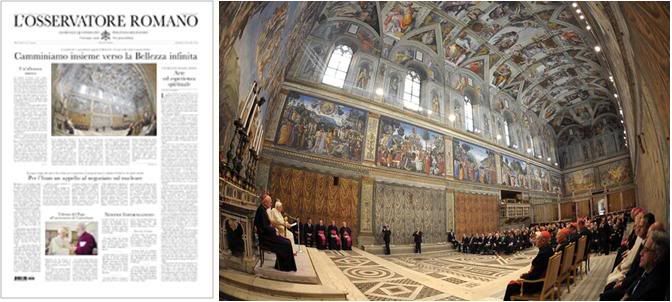
Benedict XVI's friendly and passionate appeal to artists at the Sistine Chapel:
'Let us walk together towards the infinite Beauty'
 Other Page 1 stories: An editorial on the meeting with artists and an essay on art and the spiritual experience; the Pope's meeting with the Archbishop of Canterbury (no story other than the official communique released yesterday); and continuing international impatience in dealing with Iran over its nuclear arms program.
THE POPE'S DAY
Sunday Angelus
Other Page 1 stories: An editorial on the meeting with artists and an essay on art and the spiritual experience; the Pope's meeting with the Archbishop of Canterbury (no story other than the official communique released yesterday); and continuing international impatience in dealing with Iran over its nuclear arms program.
THE POPE'S DAY
Sunday Angelus - The Holy Father spoke about Christ the King, referred to the beatification today in Nazareth
of Sister Marie Alphonsine Ghattas, and the world's contemplative orders on the annual day of prayer for them.
[Modificato da TERESA BENEDETTA 22/11/2009 22:59] |
| |
 22/11/2009 18:39 22/11/2009 18:39 |
|
| | | OFFLINE | | Post: 18.923
Post: 1.571 | Registrato il: 28/08/2005
Registrato il: 20/01/2009 | Administratore | Utente Veteran | |
|
 ANGELUS TODAY
ANGELUS TODAY

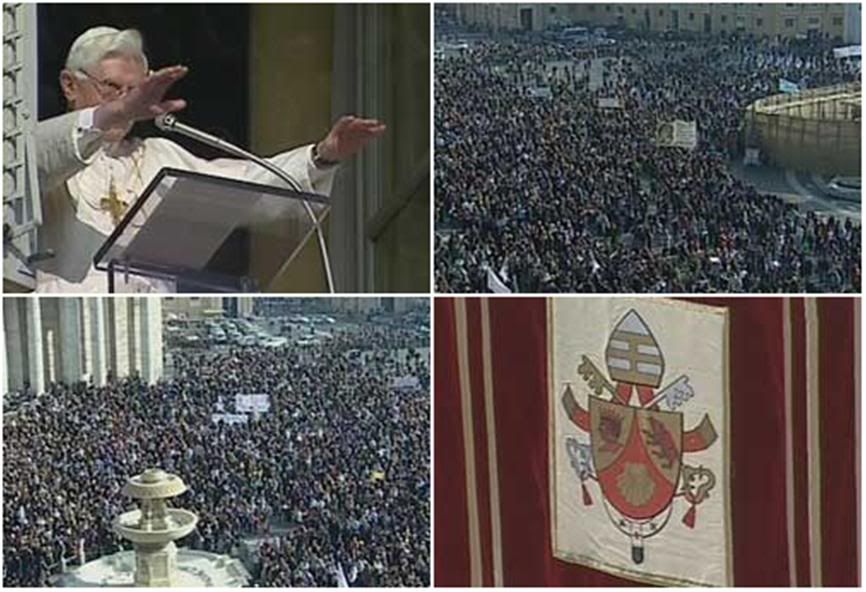 'Choosing Christ the King
'Choosing Christ the King
does not guarantee success
but ensures peace and joy'

Vatican City, Nov. 22 (AsiaNews) - "Choosing Christ does not guarantee success according to the criteria of today’s world, but ensures that peace and joy that only He can give. This is shown, in every age, by the experience of many men and women who, in Christ's name, in the name of truth and justice, have been able to resist the lure of earthly powers, with their different forms, until their fidelity was sealed with martyrdom”.
This was Benedict XVI's message today on the feast of Christ the King to the tens of thousands of pilgrims gathered on St Peter's Square. In his words before th Angelus prayers, the Pope said that this is "a celebration of relatively recent introduction, but it has deep biblical and theological roots," "it begins with the expression ‘King of the Jews' arriving then to that of ‘universal King’, Lord of the cosmos and of history, so far beyond the expectation of the same Jewish people".
After the Marian prayer. Benedict XVI spoke about the beatification of Sister Marie-Alphonsine Danil Ghattas in Nazareth today, in the presence of the Latin Patriarch of Jerusalem, Mgr. Fouad Twal and Msgr. Angelo Amato, prefect for the Congregation of Saints.
Sr. Marie-Alphonsine* was "born in Jerusalem in 1843 into a Christian family, which included nineteen children. She discovered her vocation to religious life early on, and passionately pursued it despite initial difficulties raised by her family."
"To her goes the credit of founding a congregation formed only of local women, with the aim of religious education, to overcome illiteracy and raise the conditions of women of that time in the land where Jesus exalts his dignity.
"Central point of this new spirituality and intense devotion to the Blessed Virgin Mary, the beacon of life wholly consecrated to God, the Holy Rosary was his constant prayer, his lifeline, his source of grace.
"The beatification of this most significant figure of woman is of particular comfort to the Catholic community in the Holy Land and is an invitation to trust always, with firm hope, to Divine Providence and the maternal protection of Mary. "
Before concluding with his greetings in different languages, Benedict XVI also referred to Pro Orantibus Day, dedicated to cloistered religious communities, celebrated yesterday, Feast of the Presentation of the Blessed Virgin Mary in the Temple.
"I welcome the chance," the Pontiff said, "to extend my cordial greetings to them and renew my invitation to all to support them in their needs. I am also glad, on this occasion to publicly thank the nuns who have in turn occupied the small monastery here in the Vatican: the Poor Clares, Carmelites, Benedictines and, recently, the Visitation sisters. Your prayer, dear sisters, is most valuable to my ministry. "
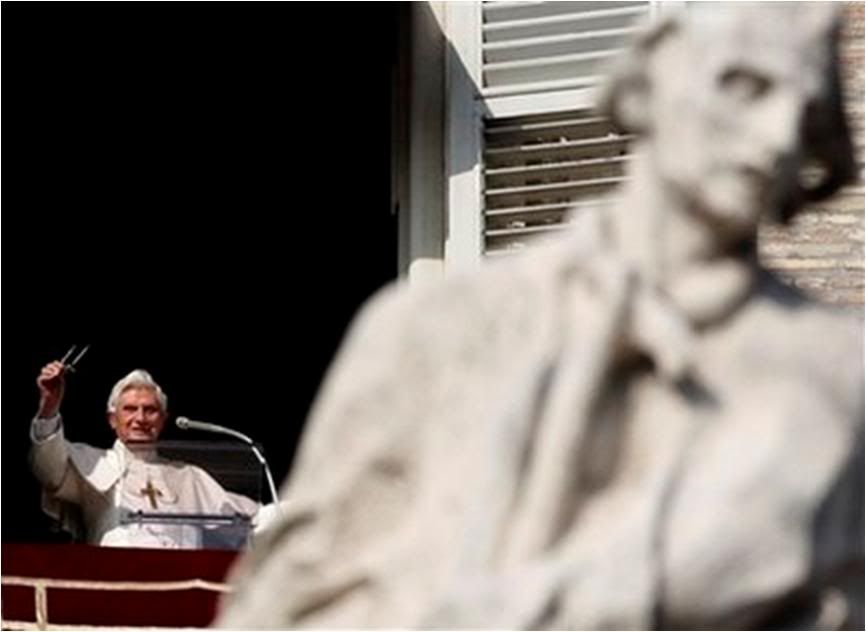
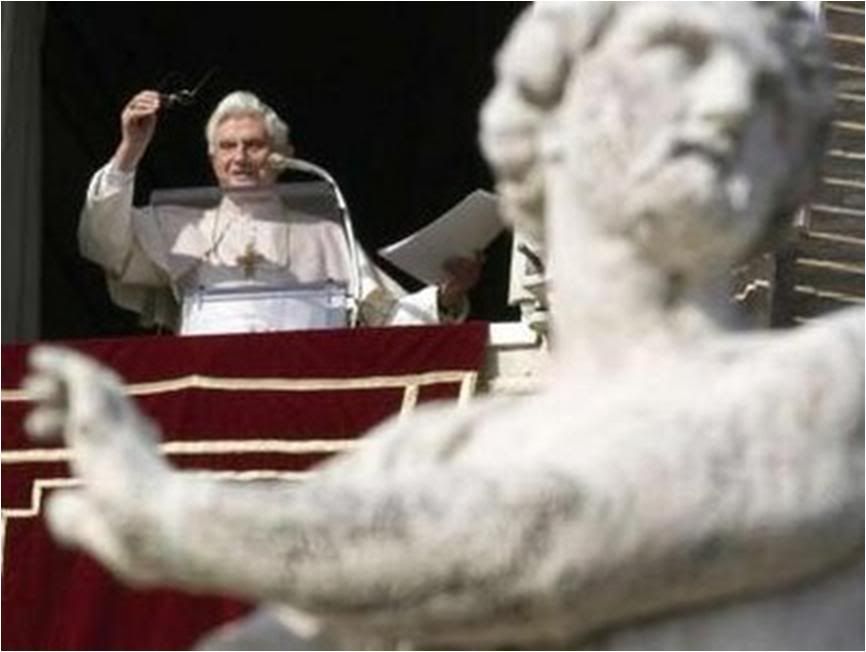
Dear brothers and sisters!
On this last Sunday of the liturgical year, we celebrate the Solemnity of Jesus Christ, King of the Universe, a feast whose institution was relatively recent, but which has profound Biblical and theological roots.
The title of King, referred to Jesus, is very important in the Goespels and allows a complete reading of his figure and his mission of salvation.
One can note in this regard a progression, starting from the expression 'King of Israel', arriving to that of universal King, Lord of the cosmos and of history - thus, far beyond the expectations of the Jewish people themselves.
Once again at the center of the course of Jesus's regality is the mystery of his death and resurrection. When Jesus was crucified, the Jewish priests, scribes and elders derided him, saying: "So he is the king of Israel! Let him come down from the cross now, and we will believe in him" (Mt 27,42).
In fact, because he was the Son of God, Jesus freely went forth to meet his passion, and the Cross is the paradoxical sign of his kingliness, which consists in the victory of God the Father's love over the disobedience of sin.
It was by offering himself in the sacrifice of expiation that Jesus became the universal King, as he himself would state when he appeared to his disciples after the Resurrection: "All power in heaven and on earth has been given to me" (mt 28,18).
But what does the 'power' of Jesus Christ, King, consist of? It is not that of the Kings and great powers of this world. It is the divine power to give eternal life, to free people from evil, to defeat the dominion of death.
It is the power of Love, which can bring good from evil, soften a hardened heart, bring peace to the harshest conflict, kindle hope in the densest darkness.
This Kingdom of Grace never imposes itself but always respects our freedom. Christ came to 'bear witness to the truth' (Jn 18,37) - as he said to Pilate. Whoever accepts his testimony places himself under his 'banner', according to the image dear to St. Ignatius of Loyola.
To every conscience, therefore, yes, a choice becomes necessary: Whom do I want to follow - God or evil? Truth or lies?
To choose Christ does not guarantee success according to worldly criteria but it assures us the peace and joy that only he can give. This is shown, in every age, by the experience of so many men and women who, in the name of Christ, of truth and of justice, decided against flattering earthly powers with their various masks to the point of sealing their fidelity to Christ with their martyrdom.
Dear brothers and sisters, when the Angel Gabriel brought the announcement to Mary, he also pre-announced that her Son would inherit the throne of David and would reign forever (cfr Lk 1,32-33). The Virgin Mary believed this before giving Him to the world.
Therefore, she must have asked herself what new kind of kingliness would Jesus have, and she understood it by listening to his words and above all, by taking part intimately in the mystery of his death on the Cross and his Resurrection.
Let us ask Mary to help us to follow Jesus, our King, as she did, and to bear witness to him with all of our existence.
After the prayers, he said this:
Today, in Nazareth, the beatification ceremony took place for Sister Marie-Alphonsine Danil Ghattas, born in Jerusalem in 1943 to a Christian family of 19 children.
She discovered her vocation for religious life early, about which she was passionate despite the initial objections of her family. She had the merit of founding a Congregation consisting only of local women, for the purpose of religious instruction, in order to fight illiteracy and elevate the condition of women in the land where Jesus himself had exalted their dignity.
A central point of the new Blessed's spirituality was her intense devotion to the Virgin Mary, luminous model of a life entirely consecrated to God. The Holy Rosary was her continuous pryaer, her anchor of salvation, her source of grace.
The beatification of such a significant woman is particularly comforting to the Catholic community in the Holy Land and is an invitation for them to entrust themselves always, with firm hope, to Divine Providence and the maternal protection of Mary.
Yesterday, in commemoration of the Presentation of the Blessed Virgin Mary in the Temple, Pro Orantibus Day ['For those who pray'] was observed, in behalf of the cloistered religious communities.
I am glad for the opportunity to address my heartfelt greeting to them, as I renew to everyone the invitation to support them in all their needs.
I am also happy, in these circumstances, to publicly thank the nuns who have been assigned to the small monastery in the Vatican: Poor Clares, Carmelties, Benedictines, and recently, Sisters of the Visitation. Your prayers, dear sisters, are very precious to my ministry.
In English, he said:
I am happy to greet all the English-speaking pilgrims and visitors present at this Angelus on the Solemnity of Christ the King.
His Kingdom is not built upon the power of this world but comes to us when we accept the presence of God in our hearts and live in his light.
Let us strive to follow closely in the footsteps of Christ the Servant King and bear constant witness to his merciful love and his saving truth! God’s blessings upon you all!
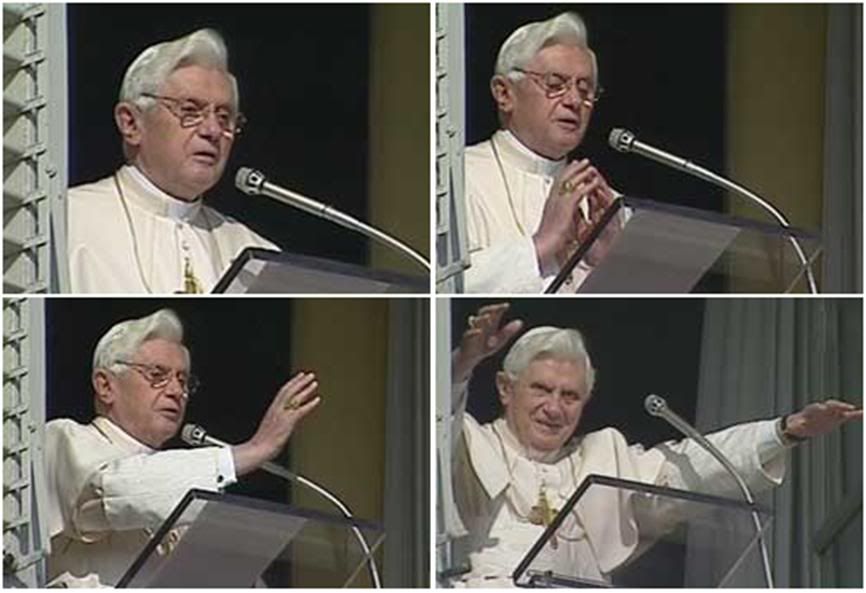
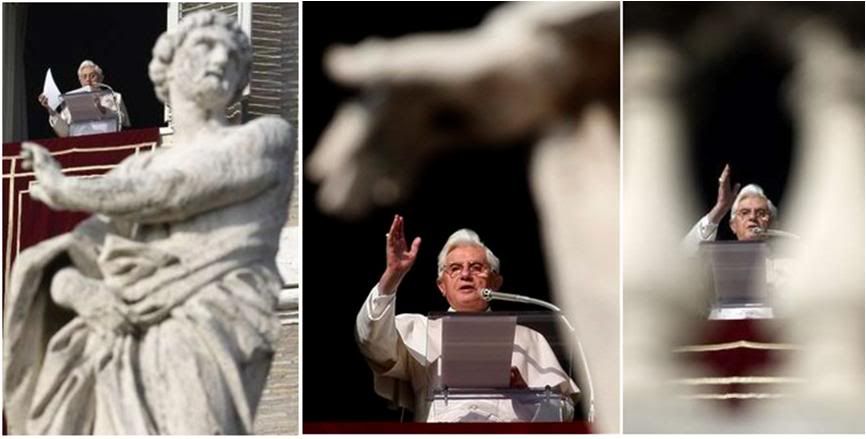
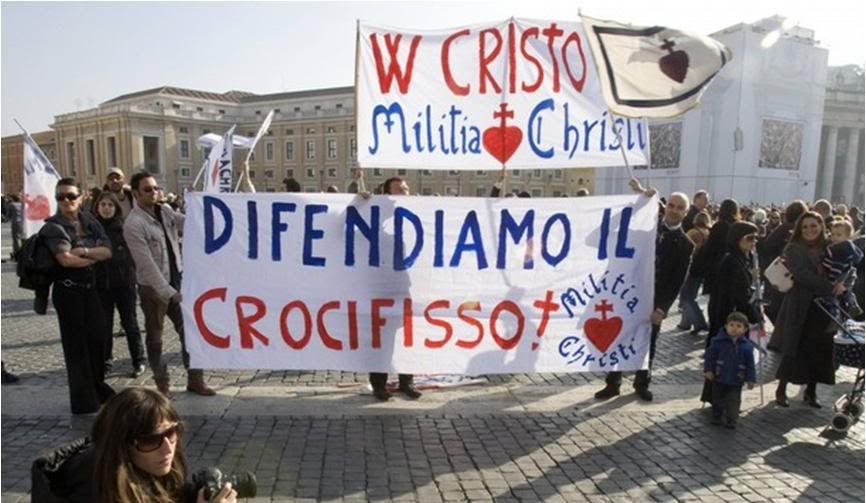 Among the faithful at Angelus today, a group demonstrating in defense of the Cross.
Among the faithful at Angelus today, a group demonstrating in defense of the Cross.
* The Latin Patriarchate of Jerusalem has a very good biography in English of Blessed Mary Alphonsine on
www.lpj.org/index.php?option=com_content&view=article&id=281:qui-est-mere-marie-alphonsine&catid=68:nouvelles&Itemid=85...
11/23/09
For the record, the Vatican Press office did not post the text of the Holy Father's Angelus message until Monday morning, Rome time, 20 hours after it was delivered.
In the Internet age [which has spoiled all of us in terms of near real-time monitoring of events as they happen], this demonstrates a serious lack of professionalism, especially since, in the almost five years that I have been following their reporting, the Press Office has been rather prompt in posting the Angelus text, generally within two hours after the Pope delivers it.
Any inability to post papal texts in a timely manner, for whatever reason, should at least be accompanied by a brief announcement that it will not be available until a given time, and preferably with an explanation of the delay.
The Press Office has accustomed online followers that Vatican bulletins for the day are generally posted at noon, Vatican time, Monday to Saturday, usually with all the papal texts of the day, and that except on Sunday, highlights from L'Osservatore Romano for the next day's issue are posted around 6 p.m., Rome time.
Professionalism, if not elementary courtesy, requires that when they are unable to do do this, they should at least put out a one-line advisory about the delay.
The Angelus text (and any homily the Pope may give if he happens to celebrate Sunday Mass in public) is the only regular responsibility of the Press Office on a Sunday. One imagines there is a rotation for Sunday duty in which whoever has the turn must make sure the text(s) is/are posted promptly.
How much time does it take to post a prepared papal text online, even allowing for a mandatory check of the prepared text against the audio recording of what the Pope actually delivered? A few minutes at the most.
Especially since the Pope does not often deviate significantly from his prepared texts, and on the occasions that he does, they are never so extensive as to require much time for transcription and for entering the ncessary changes in the prepared text.
The only excuse I can think of for yesterday's egregious failure is that the duty officer was unavailable for some reason, and no backup arrangement was in place. But certainly at least one Press Office employee lives in or near the Vatican whom the Press Office superiors could have called on to take a few minutes to do the posting. Indeed, even Fr. Lombardi or Fr. Benedettini (his deputy) could have done so themselves from the comfort of their homes.
The text was immediately available to newsmen on site, because AsiaNews, for instance, was able to provide a report directly citing big chunks of it, as did the Italian news agencies. This makes the Press Office negligence of its online responsibility all the more obvious.
[Modificato da TERESA BENEDETTA 23/11/2009 16:12] |
| |
 23/11/2009 14:26 23/11/2009 14:26 |
|
| | | OFFLINE | | Post: 18.924
Post: 1.572 | Registrato il: 28/08/2005
Registrato il: 20/01/2009 | Administratore | Utente Veteran | |
|

Monday, Nov. 23
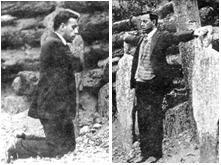 BLESSED MIGUEL AGUSTIN PRO (Mexico, 1891-1927)
BLESSED MIGUEL AGUSTIN PRO (Mexico, 1891-1927)
Jesuit and Martyr
This priest was executed by firing squad on a charge that he plotted with his brothers
to assassinate the President of Mexico. His last request was to be allowed to kneel
in prayer before he was shot (see pictures). Growing to adulthood at the height of anti-
Catholic persecution in Mexico (the 1917 Constitution outlawed the Church and imposed
severe penalties against practising the religion), Father Pro spent many years in Belgium
where he worked with coal miners before returning to Mexico in 1926, actively working in
the underground Church. Before he was shot, he cried out 'Viva Cristo Rey!' (Long live
Christ the King!). He was beatified by John Paul II in 1988.
No OR today.
THE POPE'S DAY
The Holy Father met today with
- HRH Shaikh Nasser Mohammad Al-Ahmad Al-Sabah, Prime Minister of Kuwait, and his delegation
- Bishops of Brazil (South Sector-1, Group 6) on ad limina visit
ADVENT BEGINS
 Saturday, November 28
Saturday, November 28
5:00 PM, St. Peter's Basilica
The Holy Father will preside at the First Vespers
of the First Sunday in Advent.
|
| |
 23/11/2009 17:37 23/11/2009 17:37 |
|
| | | OFFLINE | | Post: 18.925
Post: 1.573 | Registrato il: 28/08/2005
Registrato il: 20/01/2009 | Administratore | Utente Veteran | |
|
 WITH THE PRIME MINISTER OF KUWAIT
WITH THE PRIME MINISTER OF KUWAIT
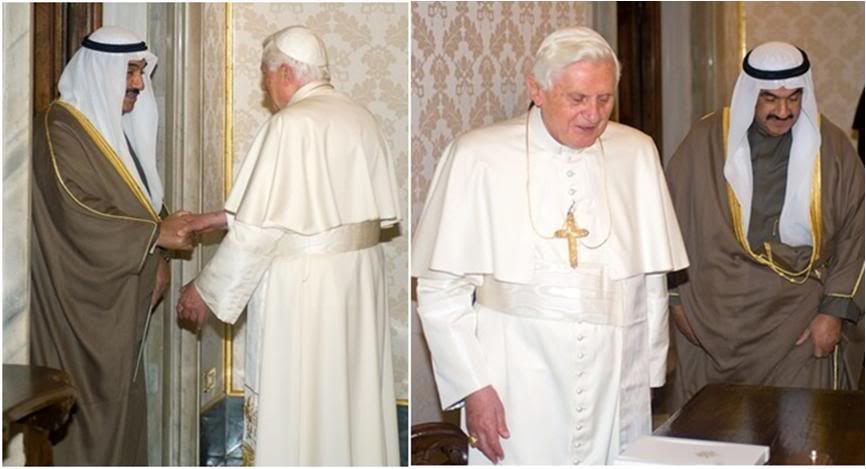
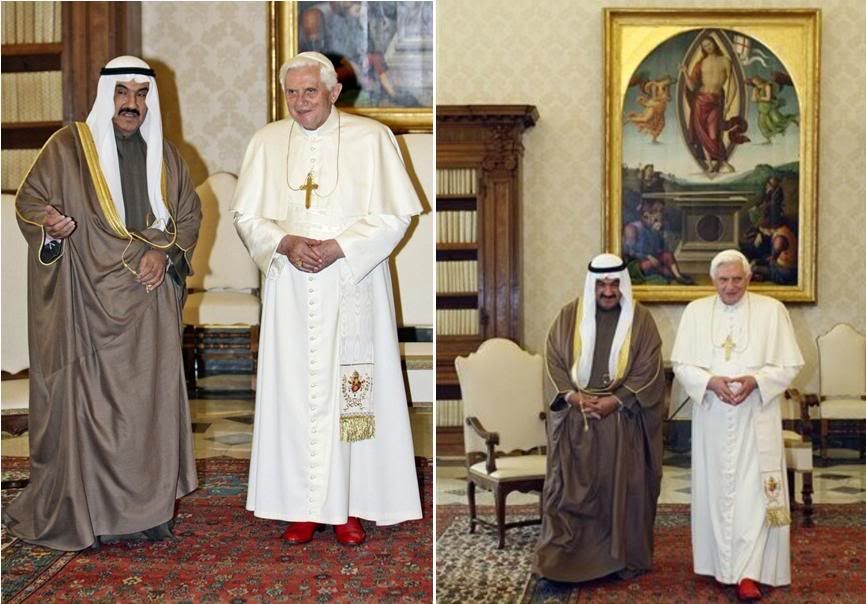
 VATICAN COMMUNIQUE
VATICAN COMMUNIQUE

Today, 23 November 2009, the Holy Father Benedict XVI received in audience Sheikh Nasser Al-Mohammad Al-Ahmad Al-Sabah, Prime Minister of the State of Kuwait.
The Prime Minister subsequently went on to meet Cardinal Secretary of State Tarcisio Bertone S.D.B. who was accompanied by Archbishop Dominique Mamberti, secretary for Relations with States.
During the cordial discussions mention was made of the excellent bilateral relations, which have existed for more than forty years, between the Holy See and Kuwait.
Likewise, consideration was given to certain questions of mutual interest, with particular reference to the promotion of peace and inter-religious dialogue in the Middle East.
Subsequently, emphasis was given to the positive contribution that the significant Christian minority makes to Kuwaiti society, underlining the need for pastoral assistance to that community.
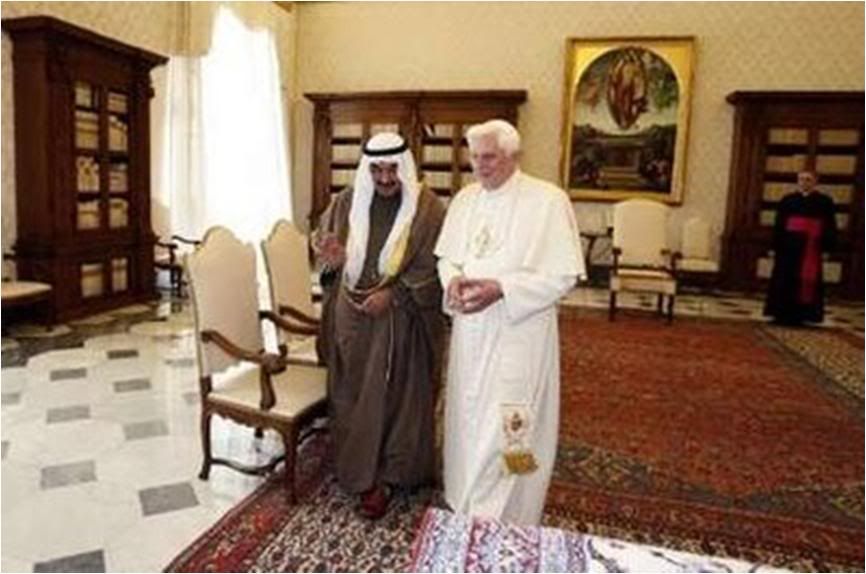
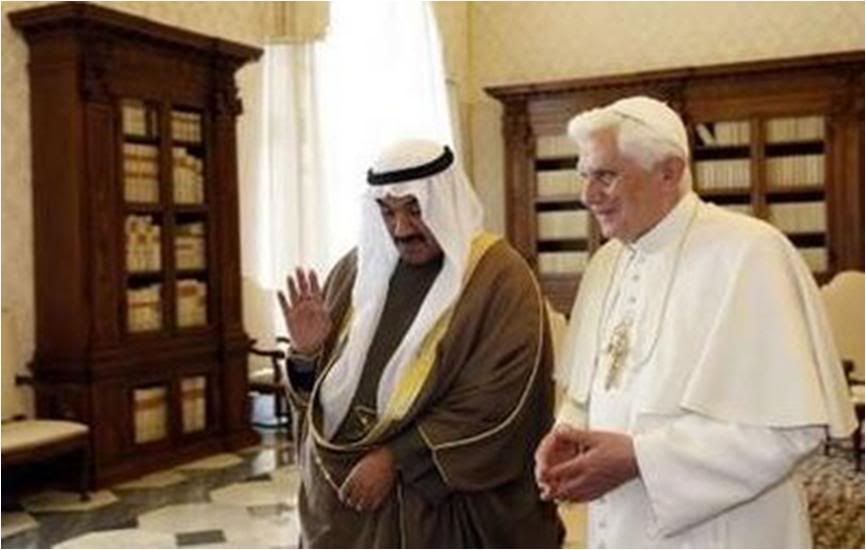
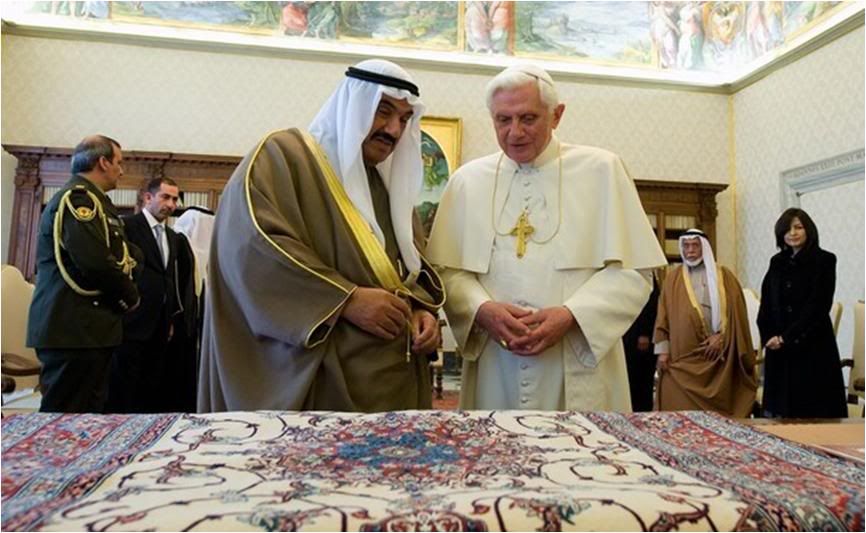

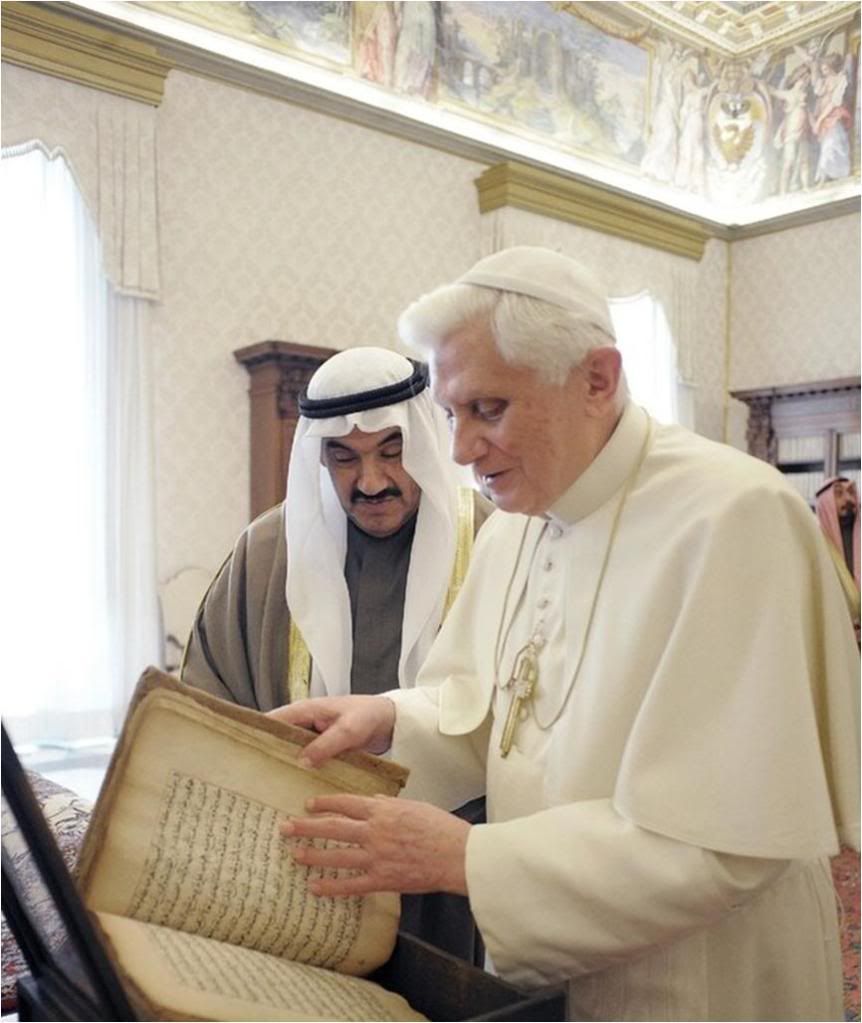

[Modificato da TERESA BENEDETTA 25/11/2009 14:27] |
| |
|
|
|
|